Submitted:
06 September 2023
Posted:
07 September 2023
You are already at the latest version
Abstract
Keywords:
1. Introduction
2. Crystal Structure and Band Structure of Ferromagnetic FexGeTe2
3. Synthesis of Metallic FexGeTe2 with FM
3.1. Solid-State Reaction (SSR)
3.2. Chemical Vapor Transort (CVT)
3.3. Flux Growth
3.4. Exfoliation
3.4.1. Mechanical Exfoliation
3.4.2. Liquid-Phase Exfoliation
3.5. Chemical Vapor Deposition (CVD)
3.6. Molecular Beam Epitaxy (MBE)
4. Controlling FM in metallic FexGeTe2 (3≤x≤7)
4.1. Fe stoichiometry
4.2. Strain Engineering
4.3. Hydrostatic Pressure
4.4. Light Control
4.5 Electrical Control
4.6. Proximity Effects
4.7. Doping Engineering
4.7.1. Doping with 3d Transition-Metal
4.7.2. Doping with Non-Metallic Atoms
4.7.3. Electron Doping
4.7.4. Hole Doping
4.8. Intercalation or Irradiation
4.9. Twisting
4.10. Patterning
5. FGT-Based Devices
6. Outlook
Author Contributions
Funding
Institutional Review Board Statement
Informed Consent Statement
Data Availability Statement
Conflicts of Interest
Abbreviations
| 2D | Two-dimensional |
| 3D | Three-dimensional |
| AFM | Antiferromagnetism |
| ATMs | Atomically thin materials |
| CGT | Cr2Ge2Te6 |
| CS-CVD | Confined space chemical vapor deposition |
| CVD | Chemical vapor deposition |
| CVT | Chemical vapor transport |
| DFT | Density functional theory |
| DOS | Density of states |
| EB | Exchange-bias |
| EDXS | Energy-dispersive X-ray spectroscopy |
| EDS | Energy dispersive spectroscopy |
| EDX | X-ray spectroscopy |
| FAG | Flux-assisted growth |
| FGT | Fe3GeTe2 |
| F4GT | Fe4GeTe2 |
| F5GT | Fe5GeTe2 |
| FIB | Focused ion beam |
| FM | Ferromagnetism |
| FPS | FePS3 |
| GGA | Generalized-gradient approximation |
| HAADF | High-angle annular dark-field |
| HRTEM | High resolution transmission electron microscopy |
| LDA | Local density approximation |
| LDA+U | Local density approximation plus Hubbard U |
| LICGC | Lithium-ion conducting glass-ceramics |
| LR | Long-range |
| MAE | Magnetic anisotropy energy |
| MBE | Molecular beam epitaxy |
| MC | Monte Carlo |
| MCD | Magnetic circular dichroism |
| MFT | Mean field theory |
| MOKE | Magneto-optical Kerr effect |
| MTJ | Magnetic tunnel junctions |
| NDC | Negative differential conductance |
| PBE | Perdew−Burke−Ernzerhof |
| PEEM | Photoemission electron microscopy |
| PET | Polyethyleneterephthalate |
| RHEED | Reflection high-energy electron diffraction |
| PI | Polyimide |
| PM | Paramagnetism |
| PRA | Random phase approximation |
| PVA | polyvinyl alcohol |
| p-xrd | Powder x-ray diffraction |
| RT | Room temperature |
| RTFM | Room-temperature ferromagnetism |
| SAED | Selected area electron diffraction |
| Sc-xrd | Single-crystal x-ray |
| SEM | Scanning electron microscopy |
| SQUID | Superconducting quantum interference device magnetometry |
| SOC | Spin-orbit coupling |
| SSR | Solid-state reaction |
| STEM | Scanning transmission electron microscopy |
| STM | Scanning tunneling microscopy |
| STT | Spin-transfer torque |
| TMR | Tunneling magnetoresistance |
| TS-LPE | Three-stage sonication-assisted liquid-phase exfoliation |
| XRD | X-ray diffraction |
| R | Bending radius |
| T | Film thickness |
| TC | Curie temperature |
| J | Exchange coupling constant |
| Total energy difference | |
| Ε | The applied strain |
References
- Mermin, N.D.; Wagner, H. Absence of Ferromagnetism or Antiferromagnetism in One- or Two-Dimensional Isotropic Heisenberg Models. Phys. Rev. Lett. 1966, 17, 1133–1136. [Google Scholar] [CrossRef]
- Hohenberg, P.C. Existence of Long-Range Order in One and Two Dimensions. Phys. Rev. B 1967, 158, 383–386. [Google Scholar] [CrossRef]
- Miller, J.L. Ferromagnetism found in two-dimensional materials. Phys. Today 2017, 70, 16–19. [Google Scholar] [CrossRef]
- Gong, C.; Li, L.; Li, Z.; Ji, H.; Stern, A.; Xia, Y.; Cao, T.; Bao, W.; Wang, C.; Wang, Y.; et al. Discovery of intrinsic ferromagnetism in two-dimensional van der Waals crystals. Nature 2017, 546, 265–269. [Google Scholar] [CrossRef]
- Huang, B.; Clark, G.; Navarro-Moratalla, E.; Klein, D.R.; Cheng, R.; Seyler, K.L.; Zhong, D.; Schmidgall, E.; McGuire, M.A.; Cobden, D.H.; et al. Layer-dependent ferromagnetism in a van der Waals crystal down to the monolayer limit. Nature 2017, 546, 270–273. [Google Scholar] [CrossRef]
- Jiang, S.; Li, L.; Wang, Z.; Mak, K.F.; Shan, J. Controlling magnetism in 2D CrI3 by electrostatic doping. Nat. Nanotechnol. 2018, 13, 549–553. [Google Scholar] [CrossRef] [PubMed]
- Liu, S.S.; Yuan, X.; Zou, Y.C.; Sheng, Y.; Huang, C.; Zhang, E.Z.; Ling, J.W.; Liu, Y.W.; Wang, W.Y.; Zhang, C. ; et. al. Wafer-scale two-dimensional ferromagnetic Fe3GeTe2 thin films grown by molecular beam epitaxy. npj 2D Mater. Appl. 2017, 1, 30. [Google Scholar]
- León-Brito, N.; Bauer, E.D.; Ronning, F.; Thompson, J.D.; Movshovich, R. Magnetic microstructure and magnetic properties of uniaxial itinerant ferromagnet Fe3GeTe2. J. Appl. Phys. 2016, 120, 083903. [Google Scholar] [CrossRef]
- May, A. F.; Calder, S.; Cantoni, C.; Cao, H.B.; McGuire, M.A. Magnetic structure and phase stability of the van der Waals bonded ferromagnet Fe3-XGeTe2. Phys. Rev. B 2016, 93, 014411. [Google Scholar] [CrossRef]
- Zhu, J.X.; Janoschek, M.; Chaves, D.S.; Cezar, J.C.; Durakiewicz, T.; Ronning, F.; Sassa, Y.; Mansson, M.; Scott, B.L.; Wakeham, N.; Bauer, E.D.; Thompson, J.D. Electronic correlation and magnetism in the ferromagnetic metal Fe3GeTe2. Phys. Rev. B 2016, 93, 144404. [Google Scholar] [CrossRef]
- Liu, Y.; Ivanovski, V.N.; Petrovic, C. Critical behavior of the van der Waals bonded ferromagnet Fe3-XGeTe2. Phys. Rev. B 2017, 96, 144429. [Google Scholar] [CrossRef]
- Wang, Y. H.; Xian, C.; Wang, J.; Liu, B.J.; Ling, L.S.; Zhang, L.; Cao, L.; Qu, Z.; Xiong, Y.M. Anisotropic anomalous hall effect in triangular itinerant ferromagnet Fe3GeTe2. Phys. Rev. B 2017, 96, 134428. [Google Scholar] [CrossRef]
- Yi, J. Y.; Zhuang, H.L.; Zou, Q.; Wu, Z.M.; Cao, G.X.; Tang, S.W.; Calder, S.A.; Kent, P.R.C.; Mandrus, D.; Gai, Z. Competing antiferromagnetism in a quasi-2D itinerant ferromagnet: Fe3GeTe2. 2D Mater. 2017, 4, 011005. [Google Scholar] [CrossRef]
- Deng, Y.; Yu, Y.; Song, Y.; Zhang, J.; Wang, N.Z.; Sun, Z.; Yi, Y.; Wu, Y.Z.; Wu, S.; Zhu, J.; et al. Gate-tunable room-temperature ferromagnetism in two-dimensional Fe3GeTe2. Nature 2018, 563, 94–99. [Google Scholar] [CrossRef] [PubMed]
- Fei, Z.; Huang, B.; Malinowski, P.; Wang, W.; Song, T.; Sanchez, J.; Yao, W.; Xiao, D.; Zhu, X.; May, A.F.; et al. Two-dimensional itinerant ferromagnetism in atomically thin Fe3GeTe2. Nat. Mater. 2018, 17, 778–782. [Google Scholar] [CrossRef] [PubMed]
- Li, Q.; Yang, M.M.; Gong, C.; Chopdekar, R.V.; N’Diaye, A.T.; Turner, J.; Chen, G.; Scholl, A.; Shafer, P.; Arenholz, E.; et al. Patterning-induced ferromagnetism of Fe3GeTe2 van der Waals materials beyond room temperature. Nano Lett. 2018, 18, 5974–5980. [Google Scholar] [CrossRef] [PubMed]
- Tan, C.; Lee, J.; Jung, S.-G.; Park, T.; Albarakati, S.; Partridge, J.; Field, M.R.; McCulloch, D.G.; Wang, L.; Lee, C. Hard magnetic properties in nanoflake van der Waals Fe3GeTe2. Nat. Commun. 2018, 9, 1–7. [Google Scholar] [CrossRef]
- Wang, Z.; Sapkota, D.; Taniguchi, T.; Watanabe, K.; Mandrus, D.; Morpurgo, A.F. Tunneling spin valves based on Fe3GeTe2/hBN/ Fe3GeTe2 van der Waals heterostructures. Nano Lett. 2018, 18, 4303–4308. [Google Scholar] [CrossRef]
- Albarakati, S.; Tan, C.; Chen, Z.J.; Partridge, J.G.; Zheng, G.L.; Farrar, L.; Mayes, E.L.H.; Field, M.R.; Lee, C.G.; Wang, Y.H. ; et. al. Antisymmetric magnetoresistance in van der Waals Fe3GeTe2/graphene/Fe3GeTe2 trilayer heterostructures. Sci. Adv. 2019, 5, eaaw0409. [Google Scholar]
- Alghamdi, M.; Lohmann, M.; Li, J.X.; Jothi, P.R.; Shao, Q.M.; Aldosary, M.; Su, T.; Fokwa, B.P.T.; Shi, J. Highly efficient spin-orbit torque and switching of layered ferromagnet Fe3GeTe2. Nano Lett. 2019, 19, 4400–4405. [Google Scholar] [CrossRef] [PubMed]
- Calder, S.; Kolesnikov, A.I.; May, A.F. Magnetic excitations in the quasi-two-dimensional ferromagnet Fe3GeTe2 measured with inelastic neutron scattering. Phys. Rev. B 2019, 99, 094423. [Google Scholar] [CrossRef]
- Johansen, O.; Risinggard, V.; Sudbo, A.; Linder, J.; Brataas, A. Current control of magnetism in two-dimensional Fe3GeTe2. Phys. Rev. Lett. 2019, 122, 217203. [Google Scholar] [CrossRef] [PubMed]
- Kim, D.; Park, S.; Lee, J.; Yoon, J.; Joo, S.; Kim, T.; Min, K.J.; Park, S.Y.; Kim, C.; Moon, K.W.; et al. Antiferromagnetic coupling of van der waals ferromagnetic Fe3GeTe2. Nanotechnology 2019, 30, 245701. [Google Scholar] [CrossRef]
- Idzuchi, H.; Llacsahuanga Allcca, A.E.; Pan, X.C.; Tanigaki, K.; Chen, Y.P. Increased curie temperature and enhanced perpendicular magneto anisotropy of Cr2Ge2Te6/NiO heterostructures. Appl. Phys. Lett. 2019, 115, 232403. [Google Scholar] [CrossRef]
- Khan, I.; Hong, J. High Curie temperature and strain-induced semiconductor-metal transition with spin reorientation transition in 2D CrPbTe3 monolayer. Nanotechnology 2020, 31, 195704. [Google Scholar] [CrossRef] [PubMed]
- Selter, S.; Bastien, G.; Wolter, A.U.B.; Aswartham, S.; Büchner, B. Magnetic anisotropy and low-field magnetic phase diagram of the quasi-two-dimensional ferromagnet Cr2Ge2Te6. Phys. Rev. B 2020, 101, 014440. [Google Scholar] [CrossRef]
- Šiškins, M.; Kurdi, S.; Lee, M.; Slotboom, B.J.M.; Xing, W.; Mañas-Valero, S.; Coronado, E.; Jia, S.; Han, W.; van der Sar, T.; et al. Nanomechanical probing and strain tuning of the Curie temperature in suspended Cr2Ge2Te6-based heterostructures. npj 2D Mater. Appl. 2022, 6, 1–8. [Google Scholar] [CrossRef]
- McCray, A.R.C.; Li, Y.; Qian, E.; Li, Y.; Wang, W.; Huang, Z.J.; Ma, X.M.; Liu, Y.Z.; Chung, D.Y.; Kanatzidis, M.G.; et al. Direct observation of magnetic bubble lattices and magnetoelastic effects in van der Waals Cr2Ge2Te6. Adv. Funct. Mater. 2023, 23, 2214203. [Google Scholar] [CrossRef]
- Noah, A.; Zur, Y.; Fridman, N.; Singh, S.; Gutfreund, A.; Herrera, E.; Vakahi, A.; Remennik, S.; Huber, M.E.; Gazit, S.; et al. Nano-Patterned Magnetic Edges in CrGeTe3 for Quasi 1-D Spintronic Devices. ACS Appl. Nano Mater. 2023, 6, 8627–8634. [Google Scholar] [CrossRef]
- O’Neill, A.; Rahman, S.; Zhang, Z.; Schoenherr, P.; Yildirim, T.J.; Gu, B.; Su, G.; Lu, Y.R.; Seidel, J. Enhanced room temperature ferromagnetism in highly strained 2D semiconductor Cr2Ge2Te6. ACS Nano 2023, 17, 735–742. [Google Scholar] [CrossRef]
- Spachmann, S.; Selter, S.; Büchner, B.; Aswartham, S.; Klingeler, R. Strong uniaxial pressure dependencies evidencing spin-lattice coupling and spin fluctuations in Cr2Ge2Te6. Phys. Rev. B 2023, 107, 184421. [Google Scholar] [CrossRef]
- Vijay, K.; Vavilapalli, D.S.; Arya, A.; Srivastava, S.K.; Singh, R.; Sagdeo, A.; Jha, S.N.; Kumar, K.; Banik, S. Magneto-strain effects in 2D ferromagnetic van der Waal material CrGeTe$$_3$$. Sci. Rep. 2023, 13, 1–12. [Google Scholar] [CrossRef] [PubMed]
- Li, T.; Jiang, S.; Sivadas, N.; Wang, Z.; Xu, Y.; Weber, D.; Goldberger, J.E.; Watanabe, K.; Taniguchi, T.; Fennie, C.J.; et al. Pressure-controlled interlayer magnetism in atomically thin CrI3. Nat. Mater. 2019, 18, 1303–1308. [Google Scholar] [CrossRef]
- Deng, Y.J.; Yu, Y.J.; Shi, M.Z.; Guo, Z.X.; Xu, Z.H.; Wang, J.; Chen, X.H.; Zhang, Y.B. Quantum anomalous hall effect in intrinsic magnetic topological insulator MnBi2Te4. Science 2020, 367, eaax8156. [Google Scholar] [CrossRef] [PubMed]
- Deiseroth, H.J.; Aleksandrov, K.; Reiner, C.; Kienle, L.; Kremer, R.K. Fe3GeTe2 and Ni3GeTe2 -two new layered transition-metal compounds: crystal structures, HRTEM investigations, and magnetic and electrical properties. Eur. J. Inorg. Chem. 2006, 2006, 1561–1567. [Google Scholar] [CrossRef]
- Verchenko, V.Y.; Tsirlin, A.A.; Sobolev, A.V.; Presniakov, I.A.; Shevelkov, A.V. Ferromagnetic order, strong magnetocrystalline anisotropy, and magnetocaloric effect in the layered telluride Fe3-δGeTe2. Inorg. Chem. 2015, 54, 8598–8607. [Google Scholar] [CrossRef]
- Chen, B.; Yang, J.H.; Wang, H.D.; Imai, M.; Ohta, H.; Michioka, C.; Yoshimura, K.; Fang, M.H. Magnetic properties of layered itinerant electron ferromagnet Fe3GeTe2. J Phys. Soc. Jpn. 2013, 82, 124711. [Google Scholar] [CrossRef]
- Drachuck, G.; Salman, Z.; Masters, M.W.; Taufour, V.; Lamichhane, T.N.; Lin, Q.S.; Straszheim, W.E.; Bud'ko, S.L.; Canfield, P.C. Effect of nickel substitution on magnetism in the layered van der Waals ferromagnet Fe3GeTe2. Phys. Rev. B 2018, 98, 144434. [Google Scholar] [CrossRef]
- May, A.F.; Ovchinnikov, D.; Zheng, Q.; Hermann, R.; Calder, S.; Huang, B.V.; Fei, Z.Y.; Liu, Y.H.; Xu, X.D.; McGuire, M.A. Ferromagnetism near room temperature in the cleavable van der Waals crystal Fe5GeTe2. ACS Nano 2019, 13, 4436–4442. [Google Scholar] [CrossRef]
- You, Y.R.; Gong, Y.Y.; Li, H.; Li, Z.F.; Zhu, M.M.; Tang, J.X.; Liu, E.K.; Yao, Y.; Xu, G.Z.; Xu, F. ; et. al. Angular dependence of the topological hall effect in the uniaxial van der Waals ferromagnet Fe3GeTe2. Phys. Rev. B 2019, 100, 134441. [Google Scholar]
- Ke, J.Z.; Yang, M.; Xia, W.; Zhu, H.P.; Liu, C.B.; Chen, R.; Dong, C.; Liu, W.X.; Shi, M.Y.; Guo, Y.F. ; et. al. Magnetic and magneto-transport studies of two-dimensional ferromagnetic compound Fe3GeTe2. J. Phys. Condens. Matter. 1995, 32, 405805. [Google Scholar]
- Ohta, T.; Sakai, K.; Taniguchi, H.; Driesen, B.; Okada, Y.; Kobayashi, K.; Niimi, Y. Enhancement of coercive field in atomically-thin quenched Fe5GeTe2. Appl. Phys. Express 2020, 13, 043005. [Google Scholar] [CrossRef]
- Park, S.Y.; Kim, D.S.; Liu, Y.; Hwang, J.; Kim, Y.; Kim, W.; Kim, J.Y.; Petrovic, C.; Hwang, C.; Mo, S.K.; et al. Controlling the magnetic anisotropy of the van der Waals ferromagnet Fe3GeTe2 through hole doping. Nano Lett. 2020, 20, 95–100. [Google Scholar] [CrossRef] [PubMed]
- Jiang, H.N.; Zang, Z.H.; Wang, X.G.; Que, H.F.; Wang, L.; Si, K.P.; Zhang, P.; Ye, Y.; Gong, Y.J. Thickness-tunable growth of composition-controllable two-dimensional FexGeTe2. Nano Lett. 2022, 22, 9477–9484. [Google Scholar] [CrossRef] [PubMed]
- Zhang, P.; Wang, X.; Jiang, H.; Zhang, Y.; He, Q.; Si, K.; Li, B.; Zhao, F.; Cui, A.; Wei, Y.; et al. Flux-assisted growth of atomically thin materials. Nat. Synth. 2022, 1, 864–872. [Google Scholar] [CrossRef]
- Zhuang, H. L.; Kent, P.R.C.; Hennig, R.G. Strong anisotropy and magnetostriction in the two-dimensional stoner ferromagnet Fe3GeTe2. Phys. Rev. B 2016, 93, 134407. [Google Scholar] [CrossRef]
- Huang, Y.; Pan, Y.H.; Yang, R.; Bao, L.H.; Meng, L.; Luo, H.L.; Cai, Y.Q.; Liu, G.D.; Zhao, W.J.; Zhou, Z.; et al. Universal mechanical exfoliation of large-area 2D Crystals. Nat. Commun. 2020, 11, 2453. [Google Scholar] [CrossRef]
- Wang, Y.; Wang, C.; Liang, S.; Ma, Z.; Xu, K.; Liu, X.; Zhang, L.; Admasu, A.S.; Cheong, S.; Wang, L.; et al. Strain-Sensitive Magnetization Reversal of a van der Waals Magnet. Adv. Mater. 2020, 32, e2004533. [Google Scholar] [CrossRef]
- Niu, W.; Cao, Z.; Wang, Y.L.; Wu, Z.Q.; Zhang, X.Q.; Han, W.B.; Wei, L.J.; Wang, L.X.; Xu, Y.B.; Zou, Y.M. ; et. al. Antisymmetric magnetoresistance in Fe3GeTe2 nanodevices of inhomogeneous thickness. Phys. Rev. B 2021, 104, 125429. [Google Scholar]
- Ma, S.; Li, G.; Li, Z.; Zhang, Y.; Lu, H.; Gao, Z.; Wu, J.; Long, G.; Huang, Y. 2D Magnetic Semiconductor Fe3GeTe2 with Few and Single Layers with a Greatly Enhanced Intrinsic Exchange Bias by Liquid-Phase Exfoliation. ACS Nano 2022, 16, 19439–19450. [Google Scholar] [CrossRef]
- Nair, G.K.R.; Zhang, Z.; Hou, F.; Abdelaziem, A.; Xu, X.; Yang, S.W.Q.; Zhang, N.; Li, W.; Zhu, C.; Wu, Y.; et al. Phase-pure two-dimensional FexGeTe2 magnets with near-room-temperature TC. Nano Res. 2021, 15, 457–464. [Google Scholar] [CrossRef]
- Zhou, J.; Zhu, C.; Zhou, Y.; Dong, J.; Li, P.; Zhang, Z.; Wang, Z.; Lin, Y.-C.; Shi, J.; Zhang, R.; et al. Composition and phase engineering of metal chalcogenides and phosphorous chalcogenides. Nat. Mater. 2022, 22, 450–458. [Google Scholar] [CrossRef]
- Liu, B.; Liu, S.S.; Yang, L.; Chen, Z.D.; Zhang, E.Z.; Li, Z.H.; Wu, J.; Ruan, X.Z.; Xiu, F.X.; Liu, W.Q. ; et. al. Light-tunable ferromagnetism in atomically thin Fe3GeTe2 driven by femtosecond laser pulse. Phys. Rev. Lett. 2020, 125, 267205. [Google Scholar]
- Liu, S.; Yang, K.; Liu, W.; Zhang, E.; Li, Z.; Zhang, X.; Liao, Z.; Zhang, W.; Sun, J.; Yang, Y.; et al. Two-dimensional ferromagnetic superlattices. Natl. Sci. Rev. 2019, 7, 745–754. [Google Scholar] [CrossRef]
- Roemer, R.; Liu, C.; Zou, K. Robust ferromagnetism in wafer-scale monolayer and multilayer Fe3GeTe2. npj 2D Mater. Appl. 2020, 4, 1–7. [Google Scholar] [CrossRef]
- Wang, H.; Liu, Y.; Wu, P.; Hou, W.; Jiang, Y.; Li, X.; Pandey, C.; Chen, D.; Yang, Q.; Wang, H.; et al. Above Room-Temperature Ferromagnetism in Wafer-Scale Two-Dimensional van der Waals Fe3GeTe2 Tailored by a Topological Insulator. ACS Nano 2020, 14, 10045–10053. [Google Scholar] [CrossRef] [PubMed]
- Chen, X.H.; Wang, H.T.; Liu, H.J.; Wang, C.; Wei, G.S.; Fang, C.; Wang, H.C.; Geng, C.Y.; Liu, S.J.; Li, P.Y.; et al. Generation and control of terahertz spin currents in topology-induced 2D ferromagnetic Fe3GeTe2|Bi2Te3 heterostructures. Adv. Mater. 2022, 34, 2106172. [Google Scholar] [CrossRef] [PubMed]
- Zhou, W.Y.; Bishop, A.J.; Zhu, M.L.; Lyalin, I.; Walko, R.; Gupta, J.A.; Hwang, J.; Kawakami, R.K. Kinetically controlled epitaxial growth of Fe3GeTe2 van der Waals ferromagnetic films. ACS Appl. Mater. Inter. 2022, 4, 3190–3197. [Google Scholar] [CrossRef]
- Seo, J.; Kim, D.Y.; An, E.S.; Kim, K.; Kim, G.-Y.; Hwang, S.-Y.; Kim, D.W.; Jang, B.G.; Kim, H.; Eom, G.; et al. Nearly room temperature ferromagnetism in a magnetic metal-rich van der Waals metal. Sci. Adv. 2020, 6, eaay8912. [Google Scholar] [CrossRef] [PubMed]
- Tan, C.; Xie, W.Q.; Zheng, G.L.; Aloufi, N.; Albarakati, S.; Algarni, M.; Li, J.B.; Partridge, J.; Culcer, D.; Wang, X.L.; et al. Gate-controlled magnetic phase transition in a van der Waals magnet Fe5GeTe2. Nano Lett. 2021, 21, 5599–5605. [Google Scholar] [CrossRef]
- Yang, X.X.; Zhou, X.D.; Feng, W.X.; Yao, Y.G. Strong magneto-optical effect and anomalous transport in the two-dimensional van der Waals magnets FenGeTe2 (N=3, 4, 5). Phys. Rev. B 2021, 104, 104427. [Google Scholar] [CrossRef]
- Liu, Q.; Xing, J.; Jiang, Z.; Guo, Y.; Jiang, X.; Qi, Y.; Zhao, J. Layer-dependent magnetic phase diagram in FenGeTe2 (3 ≤ n ≤ 7) ultrathin films. Commun. Phys. 2022, 5, 1–10. [Google Scholar] [CrossRef]
- Ghosh, S.; Ershadrad, S.; Borisov, V.; Sanyal, B. Unraveling effects of electron correlation in two-dimensional FenGeTe2 (N = 3, 4, 5) by dynamical mean field theory. npj Comput. Mater. 2023, 9, 86. [Google Scholar] [CrossRef]
- Wang, H.; Lu, H.; Guo, Z.; Li, A.; Wu, P.; Li, J.; Xie, W.; Sun, Z.; Li, P.; Damas, H.; et al. Interfacial engineering of ferromagnetism in wafer-scale van der Waals Fe4GeTe2 far above room temperature. Nat. Commun. 2023, 14, 1–8. [Google Scholar] [CrossRef] [PubMed]
- Ren, H.; Xiang, G. Morphology-Dependent Room-Temperature Ferromagnetism in Undoped ZnO Nanostructures. Nanomaterials 2021, 11, 3199. [Google Scholar] [CrossRef] [PubMed]
- Ren, H.T.; Xiang, G. Strain-modulated magnetism in MoS2. Nanomaterials, 2022, 12, 1929. [Google Scholar] [CrossRef]
- Ren, H.; Xiang, G. Strain Engineering of Intrinsic Ferromagnetism in 2D van der Waals Materials. Nanomaterials 2023, 13, 2378. [Google Scholar] [CrossRef]
- Ren, H.; Zhong, J.; Xiang, G. The Progress on Magnetic Material Thin Films Prepared Using Polymer-Assisted Deposition. Molecules 2023, 28, 5004. [Google Scholar] [CrossRef]
- Joe, M.; Yang, U.; Lee, C. First-principles study of ferromagnetic metal Fe5GeTe2. Nano Mater. Sci. 2019, 1, 299–303. [Google Scholar] [CrossRef]
- Hu, X.H.; Zhao, Y.H.; Shen, X.D.; Krasheninnikov, A.V.; Chen, Z.F.; Sun, L.T. Enhanced ferromagnetism and tunable magnetism in Fe3GeTe2 monolayer by strain engineering. ACS Appl. Mater. Inter. 2020, 12, 26367–26373. [Google Scholar] [CrossRef] [PubMed]
- Hu, L.; Zhou, J.; Hou, Z.; Su, W.; Yang, B.; Li, L.; Yan, M. Polymer-buried van der Waals magnets for promising wearable room-temperature spintronics. Mater. Horizons 2021, 8, 3306–3314. [Google Scholar] [CrossRef] [PubMed]
- Zhu, M.; You, Y.; Xu, G.; Tang, J.; Gong, Y.; Xu, F. Strain modulation of magnetic coupling in the metallic van der waals magnet Fe3GeTe2. Intermetallics 2021, 131, 107085. [Google Scholar] [CrossRef]
- Lim, M.; Choi, B.; Ghim, M.; Park, J.; Lee, H.W. Robustness of the intrinsic anomalous hall effect in Fe3GeTe2 to a uniaxial strain. Phys. Rev. Mater. 2023, 7, 064003. [Google Scholar] [CrossRef]
- Miao, X.Y.; Li, S.; Jiang, Z.Y.; Zhang, C.M.; Du, A.J. A strain induced polar metal phase in a ferromagnetic Fe3GeTe2 monolayer. Phys. Chem. Chem. Phys. 2023, 25, 18826–18832. [Google Scholar] [CrossRef] [PubMed]
- Wang, X.Q.; Li, Z.Y.; Zhang, M.; Hou, T.; Zhao, J.G.; Li, L.; Rahman, A.; Xu, Z.L.; Gong, J.B.; Chi, Z.H.; et al. Pressure-induced modification of the anomalous hall effect in layered Fe3GeTe2. Phys. Rev. B 2019, 100, 014407. [Google Scholar] [CrossRef]
- O'Hara, D.J.; Brubaker, Z.E.; Stillwell, R.L.; O'Bannon, E.F.; Baker, A.A.; Weber, D.; Aji, L.B.B.; Goldberger, J.E.; Kawakami, R.K.; Zieve, R.J.; et al. Suppression of magnetic ordering in Fe-deficient Fe3-xGeTe2 from application of pressure. Phys. Rev. B 2020, 102, 014407. [Google Scholar] [CrossRef]
- Wang, H.S.; Xu, R.Z.; Liu, C.; Wang, L.; Zhang, Z.; Su, H.M.; Wang, S.M.; Zhao, Y.S.; Liu, Z.J.; Yu, D.P.; et al. Pressure-dependent intermediate magnetic phase in thin Fe3GeTe2 flakes. J. Phys. Chem. Lett. 2020, 11, 7313–7319. [Google Scholar] [CrossRef] [PubMed]
- Ding, S.L.; Liang, Z.Y.; Yang, J.; Yun, C.; Zhang, P.J.; Li, Z.F.; Xue, M.Z.; Liu, Z.; Tian, G.; Liu, F.Y.; et al. Ferromagnetism in two-dimensional Fe3GeTe2; tunability by hydrostatic pressure. Phys. Rev. B 2021, 103, 094429. [Google Scholar] [CrossRef]
- Li, Z.; Tang, M.; Huang, J.; Qin, F.; Ao, L.; Shen, Z.; Zhang, C.; Chen, P.; Bi, X.; Qiu, C.; et al. Magnetic Anisotropy Control with Curie Temperature above 400 K in a van der Waals Ferromagnet for Spintronic Device. Adv. Mater. 2022, 34, e2201209. [Google Scholar] [CrossRef]
- Dang, N.T.; Kozlenko, D.P.; Lis, O.N.; Kichanov, S.E.; Lukin, Y.V.; Golosova, N.O.; Savenko, B.N.; Duong, D.L.; Phan, T.L.; Tran, T.A.; et al. High pressure-driven magnetic disorder and structural transformation in Fe3GeTe2: emergence of a magnetic quantum critical point. Adv. Sci. 2023, 10, 2206842. [Google Scholar] [CrossRef] [PubMed]
- Tengdin, P.; Gentry, C.; Blonsky, A.; Zusin, D.; Gerrity, M.; Hellbrück, L.; Hofherr, M.; Shaw, J.; Kvashnin, Y.; Delczeg-Czirjak, E.K.; et al. Direct light–induced spin transfer between different elements in a spintronic Heusler material via femtosecond laser excitation. Sci. Adv. 2020, 6, eaaz1100. [Google Scholar] [CrossRef]
- Wang, Y.-P.; Chen, X.-Y.; Long, M.-Q. Modifications of magnetic anisotropy of Fe3GeTe2 by the electric field effect. Appl. Phys. Lett. 2020, 116, 092404. [Google Scholar] [CrossRef]
- Zhao, M.T.; Zhao, Y.Y.; Xi, Y.L.; Xu, H.; Feng, H.F.; Xu, X.; Hao, W.C.; Zhou, S.; Zhao, J.J.; Dou, S.X.; et al. Electric-field-driven negative differential conductance in 2D van der Waals ferromagnet Fe3GeTe2. Nano Lett. 2021, 21, 9233–9039. [Google Scholar] [CrossRef]
- Zhang, L.; Huang, X.; Dai, H.; Wang, M.; Cheng, H.; Tong, L.; Li, Z.; Han, X.; Wang, X.; Ye, L.; et al. Proximity-Coupling-Induced Significant Enhancement of Coercive Field and Curie Temperature in 2D van der Waals Heterostructures. Adv. Mater. 2020, 32, e2002032. [Google Scholar] [CrossRef]
- Chen, Q.; Liang, J.; Fang, B.; Zhu, Y.H.; Wang, J.C.; Lv, W.M.; Lv, W.X.; Cai, J.L.; Huang, Z.C.; Zhai, Y.; et al. Proximity effect of a two-dimensional van der Waals magnet Fe3GeTe2 on nickel films. Nanoscale, 2021, 13, 14688–14693. [Google Scholar] [CrossRef]
- Tu, Z.Y.; Zhou, T.; Ersevim, T.; Arachchige, H.S.; Hanbicki, A.T.; Friedman, A.L.; Mandrus, D.; Ouyang, M.; Žutić, I.; Gong, C. Spin–orbit coupling proximity effect in MoS2/Fe3GeTe2 heterostructures. Appl. Phys. Lett. 2022, 120, 043102. [Google Scholar] [CrossRef]
- Zhang, L.; Song, L.; Dai, H.; Yuan, J.-H.; Wang, M.; Huang, X.; Qiao, L.; Cheng, H.; Wang, X.; Ren, W.; et al. Substrate-modulated ferromagnetism of two-dimensional Fe3GeTe2. Appl. Phys. Lett. 2020, 116, 042402. [Google Scholar] [CrossRef]
- Kim, S.J.; Choi, D.; Kim, K.-W.; Lee, K.-Y.; Kim, D.-H.; Hong, S.; Suh, J.; Lee, C.; Kim, S.K.; Park, T.-E.; et al. Interface Engineering of Magnetic Anisotropy in van der Waals Ferromagnet-based Heterostructures. ACS Nano 2021, 15, 16395–16403. [Google Scholar] [CrossRef]
- Xu, M.; Kendrick, L.H.; Kale, A.; Gang, Y.; Ji, G.; Scalettar, R.T.; Lebrat, M.; Greiner, M. Frustration- and doping-induced magnetism in a Fermi–Hubbard simulator. Nature 2023, 620, 971–976. [Google Scholar] [CrossRef] [PubMed]
- Verchenko, V.Y.; Sokolov, S.S.; Tsirlin, A.A.; Sobolev, A.V.; Presniakov, I.A.; Bykov, M.A.; Kirsanova, M.A.; Shevelkov, A.V. New Fe-based layered telluride Fe3-δAs1-YTe2: synthesis, crystal structure and physical properties. Dalton Trans., 2016, 45, 16938–16947. [Google Scholar] [CrossRef]
- Yuan, D.D.; Jin, S.F.; Liu, N.; Shen, S.J.; Lin, Z.P.; Li, K.K.; Chen, X.L. Tuning magnetic properties in quasi-two-dimensional ferromagnetic Fe3-YGe1-XAsxTe2 (0 ≤ X ≤ 0.85). , Mater. Res. Express 2017, 4, 036103. [Google Scholar] [CrossRef]
- Tian, C.K.; Wang, C.; Ji, W.; Wang, J.C.; Xia, T.L.; Wang, L.; Liu, J.J.; Zhang, H.X.; Cheng, P. Domain wall pinning and hard magnetic phase in Co-doped bulk single crystalline Fe3GeTe2. Phys. Rev. B 2019, 99, 094429. [Google Scholar] [CrossRef]
- Jang, S.W.; Yoon, H.; Jeong, M.Y.; Ryee, S.; Kim, H.S.; Han, M.J. Origin of ferromagnetism and the effect of doping on Fe3GeTe2. Nanoscale, 2020, 12, 13501–13506. [Google Scholar] [CrossRef] [PubMed]
- May, A.F.; Du, M.H.; Cooper, V.R.; McGuire, M.A. Tuning magnetic order in the van der Waals metal Fe5GeTe2 by cobalt substitution. Phys. Rev. Mater. 2020, 4, 074008. [Google Scholar] [CrossRef]
- Tian, C.K.; Pan, F.H.; Xu, S.; Ai, K.; Xia, T.L.; Cheng, P. Tunable magnetic properties in van der Waals crystals (Fe1-XCox)5GeTe2. Appl. Phys. Lett. 2020, 116, 202402. [Google Scholar] [CrossRef]
- Zhang, S.; Liang, X.; Zhao, H.; Chen, Y.; He, Q.; Liu, J.; Lv, L.; Yang, J.; Wu, H.; Chen, L. Tuning the magnetic properties of Fe3GeTe2 by doping with 3d transition-metals. Phys. Lett. A 2021, 396, 127219. [Google Scholar] [CrossRef]
- May, A.F.; Yan, J.Q.; Hermann, R.; Du, M.H.; McGuire, M.A. Tuning the room temperature ferromagnetism in Fe5GeTe2 by arsenic substitution. 2D Mater. 2022, 9, 015013. [Google Scholar] [CrossRef]
- Yang, J.; Quhe, R.; Liu, S.Q.; Peng, Y.X.; Sun, X.T.; Zha, L.; Wu, B.C.; Shi, B.W.; Yang, C.; Shi, J.J.; et al. Gate-tunable high magnetoresistance in monolayer Fe3GeTe2 spin valves. Phys. Chem. Chem. Phys. 2020, 22, 25730–25739. [Google Scholar] [CrossRef]
- Zheng, G.L.; Xie, W.Q.; Albarakati, S.; Algarni, M.; Tan, C.; Wang, Y.H.; Peng, J.Y.; Partridge, J.; Farrar, L.; Yi, J.B.; et al. Gate-tuned interlayer coupling in van der Waals ferromagnet Fe3GeTe2 nanoflakes. Phys. Rev. Lett. 2020, 125, 047202. [Google Scholar] [CrossRef] [PubMed]
- Chen, G.Y.; Zhang, Y.; Qi, S.M.; Chen, J.H. Gate-controlled magnetic transitions in Fe3GeTe2 with lithium ion conducting glass substrate, Chinese Phys. B 2021, 30, 097504. [Google Scholar]
- Tang, M.; Huang, J.; Qin, F.; Zhai, K.; Ideue, T.; Li, Z.; Meng, F.; Nie, A.; Wu, L.; Bi, X.; et al. Continuous manipulation of magnetic anisotropy in a van der Waals ferromagnet via electrical gating. Nat. Electron. 2022, 6, 1–9. [Google Scholar] [CrossRef]
- Stahl, J.; Pomjakushin, V.; Johrendt, D. Ferromagnetism in Fe3−X−YNixGeTe2. Z. Naturforsch. 2016, 71, 273–276. [Google Scholar] [CrossRef]
- Hwang, I.; Coak, M.J.; Lee, N.; Ko, D.S.; Oh, Y.; Jeon, I.; Son, S.; Zhang, K.X.; Kim, J.; Park, J.G. Hard ferromagnetic van-der-Waals metal (Fe,Co)(3)GeTe2: a new platform for the study of low-dimensional magnetic quantum criticality. J. Phys. Condens. Matter. 2019, 31, 50LT01. [Google Scholar] [CrossRef] [PubMed]
- Shen, Z.X.; Bo, X.Y.; Cao, K.; Wan, X.G.; He, L.X. Magnetic ground state and electron-doping tuning of curie temperature in Fe3GeTe2: first-principles studies. Phys. Rev. B 2021, 103, 085102. [Google Scholar] [CrossRef]
- Zhao, M.T.; Chen, B.B.; Xi, Y.L.; Zhao, Y.Y.; Xu, H.; Zhang, H.R.; Cheng, N.Y.; Feng, H.F.; Zhuang, J.C.; Pan, F.; et al. Kondo holes in the two-dimensional itinerant ising ferromagnet Fe3GeTe2. Nano Lett. 2021, 21, 6117–6123. [Google Scholar] [CrossRef] [PubMed]
- Weber, D.; Trout, A.H.; McComb, D.W.; Goldberger, J.E. Decomposition-induced room-temperature magnetism of the Na-intercalated layered ferromagnet Fe3-xGeTe2. Nano Lett. 2019, 19, 5031–5035. [Google Scholar] [CrossRef] [PubMed]
- Wu, Y.S.; Hu, Y.X.; Wang, C.; Zhou, X.; Hou, X.F.; Xia, W.; Zhang, Y.W.; Wang, J.H.; Ding, Y.F.; He, J.D.; et al. Fe-intercalation dominated ferromagnetism of van der Waals Fe3GeTe2. Adv. Mater. 2023, 2302568. [Google Scholar] [CrossRef] [PubMed]
- Yang, M.M.; Li, Q.; Chopdekar, R.V.; Stan, C.; Cabrini, S.; Choi, J.W.; Wang, S.; Wang, T.Y.; Gao, N.; Scholl, A.; et al. Highly enhanced curie temperature in Ga-implanted Fe3GeTe2 van der Waals material. Adv. Quantum Technol. 2020, 3, 2000017. [Google Scholar] [CrossRef]
- Chen, D.; Sun, W.; Wang, W.X.; Li, X.N.; Li, H.; Cheng, Z.X. Twist-stacked 2D bilayer Fe3GeTe2 with tunable magnetism. J. Mater. Chem. C 2022, 10, 12741–12750. [Google Scholar] [CrossRef]
- Ko, E. Hybridized bands and stacking-dependent band edges in ferromagnetic Fe3GeTe2/CrGeTe3 moiré heterobilayer. Sci. Rep-uk. 2022, 12, 5101. [Google Scholar] [CrossRef]
- Li, X.L.; Lu, J.T.; Zhang, J.; You, L.; Su, Y.R.; Tsymbal, E.Y. Spin-dependent transport in van der Waals magnetic tunnel junctions with Fe3GeTe2 electrodes. Nano Lett. 2019, 19, 5133–5139. [Google Scholar] [CrossRef]
- Su, Y.; Li, X.; Zhu, M.; Zhang, J.; You, L.; Tsymbal, E.Y. Van der Waals Multiferroic Tunnel Junctions. Nano Lett. 2020, 21, 175–181. [Google Scholar] [CrossRef]
- Lin, Z.; Chen, X. Ultrathin Scattering Spin Filter and Magnetic Tunnel Junction Implemented by Ferromagnetic 2D van der Waals Material. Adv. Electron. Mater. 2020, 6. [Google Scholar] [CrossRef]
- Wang, Z.-A.; Xue, W.; Yan, F.; Zhu, W.; Liu, Y.; Zhang, X.; Wei, Z.; Chang, K.; Yuan, Z.; Wang, K. Selectively Controlled Ferromagnets by Electric Fields in van der Waals Ferromagnetic Heterojunctions. Nano Lett. 2023, 23, 710–717. [Google Scholar] [CrossRef] [PubMed]
- Zhao, B.; Ngaloy, R.; Ghosh, S.; Ershadrad, S.; Gupta, R.; Ali, K.; Hoque, A.M.; Karpiak, B.; Khokhriakov, D.; Polley, C. A room-temperature spin-valve with van der Waals ferromagnet Fe5GeTe2/graphene heterostructure. Adv. Mater. 2023, 35, 2209113. [Google Scholar] [CrossRef] [PubMed]
- Hu, C.; Zhang, D.; Yan, F.; Li, Y.; Lv, Q.; Zhu, W.; Wei, Z.; Chang, K.; Wang, K. From two- to multi-state vertical spin valves without spacer layer based on Fe3GeTe2 van der Waals homo-junctions. Sci. Bull. 2020, 65, 1072–1077. [Google Scholar] [CrossRef] [PubMed]
- Zhu, W.; Lin, H.; Yan, F.; Hu, C.; Wang, Z.; Zhao, L.; Deng, Y.; Kudrynskyi, Z.R.; Zhou, T.; Kovalyuk, Z.D.; et al. Large Tunneling Magnetoresistance in van der Waals Ferromagnet/Semiconductor Heterojunctions. Adv. Mater. 2021, 33, 2104658. [Google Scholar] [CrossRef] [PubMed]
- Wang, X.; Tang, J.; Xia, X.X.; He, C.L.; Zhang, J.W.; Liu, Y.Z.; Wan, C.H.; Fang, C.; Guo, C.Y.; Yang, W.L.; et al. Current-driven magnetization switching in a van der Waals ferromagnet Fe3GeTe2. Sci. Adv. 2019, 5, eaaw8904. [Google Scholar] [CrossRef]
- Moriya, T. Theory of itinerant electron magnetism. J. Magn. Magn. Mater. 1991, 100, 261–271. [Google Scholar] [CrossRef]
- Li, G.; Ma, S.; Li, Z.; Zhang, Y.; Diao, J.; Xia, L.; Zhang, Z.; Huang, Y. High-Quality Ferromagnet Fe3GeTe2 for High-Efficiency Electromagnetic Wave Absorption and Shielding with Wideband Radar Cross Section Reduction. ACS Nano 2022, 16, 7861–7879. [Google Scholar] [CrossRef] [PubMed]
- Zhang, Y.; Lu, H.Y.; Zhu, X.G.; Tan, S.Y.; Feng, W.; Liu, Q.; Zhang, W.; Chen, Q.Y.; Liu, Y.; Luo, X.B.; et al. Emergence of kondo lattice behavior in a van der Waals itinerant ferromagnet Fe3GeTe2. Sci. Adv. 2018, 4, eaao6791. [Google Scholar] [CrossRef] [PubMed]
- Canfield, P.C.; Fisk, Z. Growth of single crystals from metallic fluxes. Philos. Mag. B 1992, 65, 1117–1123. [Google Scholar] [CrossRef]
- Canfield, P.C.; Fisher, I.R. High-temperature solution growth of intermetallic single crystals and quasicrystals. J. Cryst. Growth 2001, 225, 155–161. [Google Scholar] [CrossRef]
- Yan, J.-Q.; Sales, B.C.; Susner, M.A.; McGuire, M.A. Flux growth in a horizontal configuration: An analog to vapor transport growth. Phys. Rev. Mater. 2017, 1, 023402. [Google Scholar] [CrossRef]
- Milosavljević, A.; Šolajić, A.; Djurdjić-Mijin, S.; Pešić, J.; Višić, B.; Liu, Y.; Petrovic, C.; Lazarević, N.; Popović, Z.V. Lattice dynamics and phase transitions in Fe3-xGeTe2. Phys. Rev. B 2019, 99, 214304. [Google Scholar] [CrossRef]
- Novoselov, K.S.; Geim, A.K.; Morozov, S.V.; Jiang, D.; Zhang, Y.; Dubonos, S.V.; Grigorieva, I.V.; Firsov, A.A. Electric field effect in atomically thin carbon films. Science 2004, 306, 666–669. [Google Scholar] [CrossRef] [PubMed]
- Chahal, S.; Ranjan, P.; Motlag, M.; Yamijala, S.S.R.K.C.; Late, D.J.; Sadki, E.H.S.; Cheng, G.J.; Kumar, P. Borophene via Micromechanical Exfoliation. Adv. Mater. 2021, 33, 2102039. [Google Scholar] [CrossRef] [PubMed]
- Hsu, C.-L.; Lin, C.-T.; Huang, J.-H.; Chu, C.-W.; Wei, K.-H.; Li, L.-J. Layer-by-Layer Graphene/TCNQ Stacked Films as Conducting Anodes for Organic Solar Cells. ACS Nano 2012, 6, 5031–5039. [Google Scholar] [CrossRef]
- Moon, J.-Y.; Kim, M.; Kim, S.-I.; Xu, S.; Choi, J.-H.; Whang, D.; Watanabe, K.; Taniguchi, T.; Park, D.S.; Seo, J.; et al. Layer-engineered large-area exfoliation of graphene. Sci. Adv. 2020, 6, eabc6601. [Google Scholar] [CrossRef]
- Magda, G.Z.; Pető, J.; Dobrik, G.; Hwang, C.; Biró, L.P.; Tapasztó, L. Exfoliation of large-area transition metal chalcogenide single layers. Sci. Rep-uk. 2015, 5, 14714. [Google Scholar] [CrossRef]
- Ding, D.; Wang, S.; Xia, Y.; Li, P.; He, D.; Zhang, J.; Zhao, S.; Yu, G.; Zheng, Y.; Cheng, Y.; et al. Atomistic Insight into the Epitaxial Growth Mechanism of Single-Crystal Two-Dimensional Transition-Metal Dichalcogenides on Au(111) Substrate. ACS Nano 2022, 16, 17356–17364. [Google Scholar] [CrossRef] [PubMed]
- Yang, P.; Zhang, S.; Pan, S.; Tang, B.; Liang, Y.; Zhao, X.; Zhang, Z.; Shi, J.; Huan, Y.; Shi, Y.; et al. Epitaxial Growth of Centimeter-Scale Single-Crystal MoS2 Monolayer on Au(111). ACS Nano 2020, 14, 5036–5045. [Google Scholar] [CrossRef] [PubMed]
- Reidy, K.; Varnavides, G.; Thomsen, J.D.; Kumar, A.; Pham, T.; Blackburn, A.M.; Anikeeva, P.; Narang, P.; LeBeau, J.M.; Ross, F.M. Direct imaging and electronic structure modulation of moiré superlattices at the 2D/3D interface. Nat. Commun. 2021, 12, 1–9. [Google Scholar] [CrossRef] [PubMed]
- Gao, Y.; Hong, Y.-L.; Yin, L.-C.; Wu, Z.; Yang, Z.; Chen, M.-L.; Liu, Z.; Ma, T.; Sun, D.-M.; Ni, Z.; et al. Ultrafast Growth of High-Quality Monolayer WSe2 on Au. Adv. Mater. 2017, 29. [Google Scholar] [CrossRef] [PubMed]
- May, A.F.; Yan, J.; McGuire, M.A. A practical guide for crystal growth of van der Waals layered materials. J. Appl. Phys. 2020, 128, 051101. [Google Scholar] [CrossRef]
- Lv, H.; Silva, A.D.; Figueroa, A.I.; Guillemard, C.; Aguirre, I.F.; Camosi, L.; Aballe, L.; Valvidares, M.; Valenzuela, S.O.; Schubert, J.; et al. Large-area synthesis of ferromagnetic Fe5−XGeTe2/graphene van der Waals heterostructures with curie temperature above room temperature. Small 2023, 2302387. [Google Scholar] [CrossRef]
- Wang, X.; Wu, P. Aqueous Phase Exfoliation of Two-Dimensional Materials Assisted by Thermoresponsive Polymeric Ionic Liquid and Their Applications in Stimuli-Responsive Hydrogels and Highly Thermally Conductive Films. ACS Appl. Mater. Interfaces 2018, 10, 2504–2514. [Google Scholar] [CrossRef]
- Liu, S.; Li, Z.; Yang, K.; Zhang, E.; Narayan, A.; Zhang, X.; Zhu, J.; Liu, W.; Liao, Z.; Kudo, M.; et al. Tuning 2D magnetism in Fe3+XGeTe2 films by element doping. Natl. Sci. Rev. 2021, 9, nwab117. [Google Scholar] [CrossRef] [PubMed]
- Ly, T.T.; Park, J.; Kim, K.; Ahn, H.B.; Lee, N.J.; Kim, K.; Park, T.E.; Duvjir, G.; Lam, N.H.; Jang, K.; et al. Direct observation of Fe-Ge ordering in Fe5−XGeTe2 crystals and resultant helimagnetism. Adv. Funct. Mater. 2021, 31, 2009758. [Google Scholar] [CrossRef]
- Lv, X.; Pei, K.; Yang, C.; Qin, G.; Liu, M.; Zhang, J.; Che, R. Controllable Topological Magnetic Transformations in the Thickness-Tunable van der Waals Ferromagnet Fe5GeTe2. ACS Nano 2022, 16, 19319–19327. [Google Scholar] [CrossRef]
- Yamagami, K.; Fujisawa, Y.; Driesen, B.; Hsu, C.H.; Kawaguchi, K.; Tanaka, H.; Kondo, T.; Zhang, Y.; Wadati, H.; Araki, K.; et al. Itinerant ferromagnetism mediated by giant spin polarization of the metallic ligand band in the van der Waals magnet Fe5GeTe2. Phys. Rev. B 2021, 103, L060403. [Google Scholar] [CrossRef]
- Wu, X.C.; Lei, L.; Yin, Q.W.; Zhao, N.N.; Li, M.; Wang, Z.L.; Liu, Q.X.; Song, W.H.; Ma, H.; Ding, P.F.; et al. Direct observation of competition between charge order and itinerant ferromagnetism in the van der Waals crystal Fe5-xGeTe2. Phys. Rev. B 2021, 104, 165101. [Google Scholar] [CrossRef]
- Ohta, T.; Tokuda, M.; Iwakiri, S.; Sakai, K.; Driesen, B.; Okada, Y.; Kobayashi, K.; Niimi, Y. Butterfly-shaped magnetoresistance in van der Waals ferromagnet Fe5GeTe2. AIP Adv. 2021, 11, 025014. [Google Scholar] [CrossRef]
- Zhang, H.R.; Chen, R.; Zhai, K.; Chen, X.; Caretta, L.; Huang, X.X.; Chopdekar, R.V.; Cao, J.H.; Sun, J.R.; Yao, J.; et al. Itinerant ferromagnetism in van der Waals Fe5-xGeTe2 crystals above room temperature. Phys. Rev. B 2020, 102, 144425. [Google Scholar] [CrossRef]
- Stahl, J.; Shlaen, E.; Johrendt, D. The van der Waals ferromagnets Fe5-δGeTe2 and Fe5-δ-xNixGeTe2 - crystal structure, stacking faults, and magnetic properties. Z. Anorg. Allg. Chem. 2018, 644, 1923–29. [Google Scholar] [CrossRef]
- Li, Z.; Xia, W.; Su, H.; Yu, Z.; Fu, Y.; Chen, L.; Wang, X.; Yu, N.; Zou, Z.; Guo, Y. Magnetic critical behavior of the van der Waals Fe5GeTe2 crystal with near room temperature ferromagnetism. Sci. Rep. 2020, 10, 1–10. [Google Scholar] [CrossRef] [PubMed]
- Sun, Y.; Liu, K. Strain engineering in functional 2-dimensional materials. J. Appl. Phys. 2018, 125, 082402. [Google Scholar] [CrossRef]
- Ren, H.T. ; Xiang, G; Lu, J. T.; Zhang, X.; Zhang, L. Biaxial strain-mediated room temperature ferromagnetism of ReS2 web buckles. Adv. Electron. Mater. 2019, 5, 1900814. [Google Scholar]
- Pajda, M.; Kudrnovský, J.; Turek, I.; Drchal, V.; Bruno, P. Ab initio calculations of exchange interactions, spin-wave stiffness constants, and curie temperatures of Fe, Co, and Ni. Phys. Rev. B 2001, 64, 174402. [Google Scholar] [CrossRef]
- Wang, Q.H.; Bedoya-Pinto, A. ; M. ; Dismukes, A.H.; Hamo, A.; Jenkins, S.; Koperski, M.; Liu, Y.; Sun, Q.C.; Telford, E.J.; et al. The magnetic genome of two-dimensional van der Waals materials. ACS Nano 2022, 16, 6960–7079. [Google Scholar]
- Torelli, D.; Olsen, T. Calculating critical temperatures for ferromagnetic order in two-dimensional materials. 2D Mater. 2018, 6, 015028. [Google Scholar] [CrossRef]
- Evans, R.F.L.; Atxitia, U.; Chantrell, R.W. Quantitative simulation of temperature-dependent magnetization dynamics and equilibrium properties of elemental ferromagnets. Phys. Rev. B 2015, 91, 144425. [Google Scholar] [CrossRef]
- Asselin, P.; Evans, R.F.L.; Barker, J.; Chantrell, R.W.; Yanes, R.; Chubykalo-Fesenko, O.; Hinzke, D.; Nowak, U. Constrained Monte Carlo method and calculation of the temperature dependence of magnetic anisotropy. Phys. Rev. B 2010, 82. [Google Scholar] [CrossRef]
- Li, Z.; Lv, Y.; Ren, L.; Li, J.; Kong, L.; Zeng, Y.; Tao, Q.; Wu, R.; Ma, H.; Zhao, B.; et al. Efficient strain modulation of 2D materials via polymer encapsulation. Nat. Commun. 2020, 11, 1–8. [Google Scholar] [CrossRef]
- Zhang, Y.; Shen, L.; Liu, M.; Li, X.; Lu, X.; Lu, L.; Ma, C.; You, C.; Chen, A.; Huang, C.; et al. Flexible Quasi-Two-Dimensional CoFe2O4 Epitaxial Thin Films for Continuous Strain Tuning of Magnetic Properties. ACS Nano 2017, 11, 8002–8009. [Google Scholar] [CrossRef]
- Lin, Z.S.; Lohmann, M.; Ali, Z.A.; Tang, C.; Li, J.X.; Xing, W.Y.; Zhong, J.N.; Jia, S.; Han, W.; Coh, S.; et al. Pressure-induced spin reorientation transition in layered ferromagnetic insulator Cr2Ge2Te6. Phys. Rev. Mater. 2018, 2, 051004. [Google Scholar] [CrossRef]
- Sun, Y.P.; Xiao, R.C.; Lin, G.T.; Zhang, R.R.; Ling, L.S.; Ma, Z.W.; Luo, X.; Lu, W.J.; Sheng, Z.G. Effects of hydrostatic pressure on spin-lattice coupling in two-dimensional ferromagnetic Cr2Ge2Te6. Appl. Phys. Lett. 2018, 112, 072409. [Google Scholar] [CrossRef]
- Song, T.; Fei, Z.; Yankowitz, M.; Lin, Z.; Jiang, Q.; Hwangbo, K.; Zhang, Q.; Sun, B.; Taniguchi, T.; Watanabe, K.; et al. Switching 2D magnetic states via pressure tuning of layer stacking. Nat. Mater. 2019, 18, 1298–1302. [Google Scholar] [CrossRef] [PubMed]
- Yang, L.; Sinitsyn, N.A.; Chen, W.; Yuan, J.; Zhang, J.; Lou, J.; Crooker, S.A. Long-lived nanosecond spin relaxation and spin coherence of electrons in monolayer MoS2 and WS2. Nat. Phys. 2015, 11, 830–834. [Google Scholar] [CrossRef]
- Jones, A.M.; Yu, H.; Ghimire, N.J.; Wu, S.; Aivazian, G.; Ross, J.S.; Zhao, B.; Yan, J.; Mandrus, D.G.; Xiao, D.; et al. Optical generation of excitonic valley coherence in monolayer WSe2. Nat. Nanotechnol. 2013, 8, 634–638. [Google Scholar] [CrossRef] [PubMed]
- Weisheit, M.; Fähler, S.; Marty, A.; Souche, Y.; Poinsignon, C.; Givord, D. Electric Field-Induced Modification of Magnetism in Thin-Film Ferromagnets. Science 2007, 315, 349–351. [Google Scholar] [CrossRef]
- Chiba, D.; Fukami, S.; Shimamura, K.; Ishiwata, N.; Kobayashi, K.; Ono, T. Electrical control of the ferromagnetic phase transition in cobalt at room temperature. Nat. Mater. 2011, 10, 853–856. [Google Scholar] [CrossRef] [PubMed]
- Ovchinnikov, I.V.; Wang, K.L. Theory of electric-field-controlled surface ferromagnetic transition in metals. Phys. Rev. B 2009, 79, 020402. [Google Scholar] [CrossRef]
- Maruyama, T.; Shiota, Y.; Nozaki, T.; Ohta, K.; Toda, N.; Mizuguchi, M.; Tulapurkar, A.A.; Shinjo, T.; Shiraishi, M.; Mizukami, S.; et al. Large voltage-induced magnetic anisotropy change in a few atomic layers of iron. Nat. Nanotechnol. 2009, 4, 158–161. [Google Scholar] [CrossRef] [PubMed]
- Tong, Q.; Chen, M.; Yao, W. Magnetic Proximity Effect in a van der Waals Moiré Superlattice. Phys. Rev. Appl. 2019, 12, 024031. [Google Scholar] [CrossRef]
- Dolui, K.; Petrović, M.D.; Zollner, K.; Plecháč, P.; Fabian, J.; Nikolić, B.K. Proximity Spin–Orbit Torque on a Two-Dimensional Magnet within van der Waals Heterostructure: Current-Driven Antiferromagnet-to-Ferromagnet Reversible Nonequilibrium Phase Transition in Bilayer CrI3. Nano Lett. 2020, 20, 2288–2295. [Google Scholar] [CrossRef]
- Karpiak, B.; Cummings, A.W.; Zollner, K.; Vila, M.; Khokhriakov, D.; Hoque, A.M.; Dankert, A.; Svedlindh, P.; Fabian, J.; Roche, S.; et al. Magnetic proximity in a van der Waals heterostructure of magnetic insulator and graphene. 2D Mater. 2019, 7, 015026. [Google Scholar] [CrossRef]
- Tang, C.; Zhang, Z.; Lai, S.; Tan, Q.; Gao, W. Magnetic Proximity Effect in Graphene/CrBr3 van der Waals Heterostructures. Adv. Mater. 2020, 32, 1908498. [Google Scholar] [CrossRef] [PubMed]
- Zhong, D.; Seyler, K.L.; Linpeng, X.; Wilson, N.P.; Taniguchi, T.; Watanabe, K.; McGuire, M.A.; Fu, K.-M.C.; Xiao, D.; Yao, W.; et al. Layer-resolved magnetic proximity effect in van der Waals heterostructures. Nat. Nanotechnol. 2020, 15, 187–191. [Google Scholar] [CrossRef] [PubMed]
- Liu, N.S.; Zhou, S.; Zhao, J.J. High-curie-temperature ferromagnetism in bilayer CrI3 on bulk semiconducting substrates. Phys. Rev. Mater. 2020, 4, 094003. [Google Scholar] [CrossRef]
- Dong, X.-J.; You, J.-Y.; Zhang, Z.; Gu, B.; Su, G. Great enhancement of Curie temperature and magnetic anisotropy in two-dimensional van der Waals magnetic semiconductor heterostructures. Phys. Rev. B 2020, 102, 144443. [Google Scholar] [CrossRef]
- Qin, B.; Ma, H.; Hossain, M.; Zhong, M.; Xia, Q.; Li, B.; Duan, X. Substrates in the Synthesis of Two-Dimensional Materials via Chemical Vapor Deposition. Chem. Mater. 2020, 32, 10321–10347. [Google Scholar] [CrossRef]
- Sun, Y.; Wang, R.; Liu, K. Substrate induced changes in atomically thin 2-dimensional semiconductors: Fundamentals, engineering, and applications. Appl. Phys. Rev. 2017, 4, 011301. [Google Scholar] [CrossRef]
- Ren, H.; Xiang, G. Recent Progress in Research on Ferromagnetic Rhenium Disulfide. Nanomaterials 2022, 12, 3451. [Google Scholar] [CrossRef] [PubMed]
- Ren, H.T.; Xiang, G.; Gu, G.X.; Zhang, X. Enhancement of ferromagnetism of ZnO: Co nanocrystals by post-annealing treatment: the role of oxygen interstitials and zinc vacancies. Mater. Lett. 2014, 122, 256–260. [Google Scholar] [CrossRef]
- Chen, M.; Hu, C.; Luo, X.; Hong, A.; Yu, T.; Yuan, C. Ferromagnetic behaviors in monolayer MoS2 introduced by nitrogen-doping. Appl. Phys. Lett. 2020, 116, 073102. [Google Scholar] [CrossRef]
- Tan, H.; Hu, W.; Wang, C.; Ma, C.; Duan, H.; Yan, W.; Cai, L.; Guo, P.; Sun, Z.; Liu, Q.; et al. Intrinsic Ferromagnetism in Mn-Substituted MoS2 Nanosheets Achieved by Supercritical Hydrothermal Reaction. Small 2017, 13. [Google Scholar] [CrossRef]
- Wang, J.; Sun, F.; Yang, S.; Li, Y.; Zhao, C.; Xu, M.; Zhang, Y.; Zeng, H. Robust ferromagnetism in Mn-doped MoS2 nanostructures. Appl. Phys. Lett. 2016, 109, 092401. [Google Scholar] [CrossRef]
- Gweon, H.K.; Lee, S.Y.; Kwon, H.Y.; Jeong, J.; Chang, H.J.; Kim, K.W.; Qiu, Z.Q.; Ryu, H.; Jang, C.; Choi, J.W. Exchange bias in weakly interlayer-coupled van der Waals magnet Fe3GeTe2. Nano Lett. 2021, 21, 1672–1678. [Google Scholar] [CrossRef]
- Jiang, Peiheng, Cong Wang, Dachuan Chen, Zhicheng Zhong, Zhe Yuan, Zhong-Yi Lu, and Wei Ji. Stacking tunable interlayer magnetism in bilayer CrI3. Phys. Rev. B 2019, 99, 144401.
- Sivadas, N.; Satoshi Okamoto, S.; Xu, X.D.; Fennie, C.J.; Xiao, D. Stacking-dependent magnetism in bilayer CrI3. Nano Lett. 2018, 18, 7658–7664. [Google Scholar] [CrossRef] [PubMed]
- Cao, Y.; Fatemi, V.; Fang, S.; Watanabe, K.; Taniguchi, T.; Kaxiras, E.; Jarillo-Herrero, P. Unconventional superconductivity in magic-angle graphene superlattices. Nature 2018, 556, 43–50. [Google Scholar] [CrossRef]
- Akram, M.; Erten, O. Skyrmions in twisted van der Waals magnets. Phys. Rev. B 2021, 103, L140406. [Google Scholar] [CrossRef]
- Tong, Q.; Liu, F.; Xiao, J.; Yao, W. Skyrmions in the Moiré of van der Waals 2D Magnets. Nano Lett. 2018, 18, 7194–7199. [Google Scholar] [CrossRef] [PubMed]
- Wang, C.; Gao, Y.; Lv, H.; Xu, X.; Xiao, D. Stacking Domain Wall Magnons in Twisted van der Waals Magnets. Phys. Rev. Lett. 2020, 125, 247201. [Google Scholar] [CrossRef] [PubMed]
- Ghader, D. Magnon magic angles and tunable Hall conductivity in 2D twisted ferromagnetic bilayers. Sci. Rep. 2020, 10, 1–12. [Google Scholar] [CrossRef]
- Xie, H.; Luo, X.; Ye, G.; Ye, Z.; Ge, H.; Sung, S.H.; Rennich, E.; Yan, S.; Fu, Y.; Tian, S.; et al. Twist engineering of the two-dimensional magnetism in double bilayer chromium triiodide homostructures. Nat. Phys. 2021, 18, 30–36. [Google Scholar] [CrossRef]
- Guo, H.; Hu, Z.; Liu, Z.; Tian, J. Stacking of 2D Materials. Adv. Funct. Mater. 2020, 31, 2007810. [Google Scholar] [CrossRef]
- Nguyen, G.D.; Lee, J.; Berlijn, T.; Zou, Q.; Hus, S.M.; Park, J.; Gai, Z.; Lee, C.; Li, A.P. Visualization and manipulation of magnetic domains in the quasi-two-dimensional material Fe3GeTe2. Phys. Rev. B 2018, 97, 014425. [Google Scholar] [CrossRef]
- Yin, S.Q.; Zhao, L.; Song, C.; Huang, Y.; Gu, Y.D.; Chen, R.Y.; Zhu, W.X.; Sun, Y.M.; Jiang, W.J.; Zhang, X.Z. Evolution of domain structure in Fe3GeTe2. Chinese Phys. B 2021, 30, 027505. [Google Scholar] [CrossRef]
- Zhu, W.X.; Song, C.; Wang, Q.; Bai, H.; Yin, S.Q.; Pan, F. Anomalous displacement reaction for synthesizing above-room-temperature and air-stable vdw ferromagnet PtTe2Ge1/3. Natl. Sci. Rev. 2022, 10, nwac173. [Google Scholar] [CrossRef] [PubMed]
- Tu, Z.; Xie, T.; Lee, Y.; Zhou, J.; Admasu, A.S.; Gong, Y.; Valanoor, N.; Cumings, J.; Cheong, S.-W.; Takeuchi, I.; et al. Ambient effect on the Curie temperatures and magnetic domains in metallic two-dimensional magnets. npj 2D Mater. Appl. 2021, 5, 1–6. [Google Scholar] [CrossRef]
- Cao, W.; Bu, H.; Vinet, M.; Cao, M.; Takagi, S.; Hwang, S.; Ghani, T.; Banerjee, K. The future transistors. Nature 2023, 620, 501–515. [Google Scholar] [CrossRef] [PubMed]
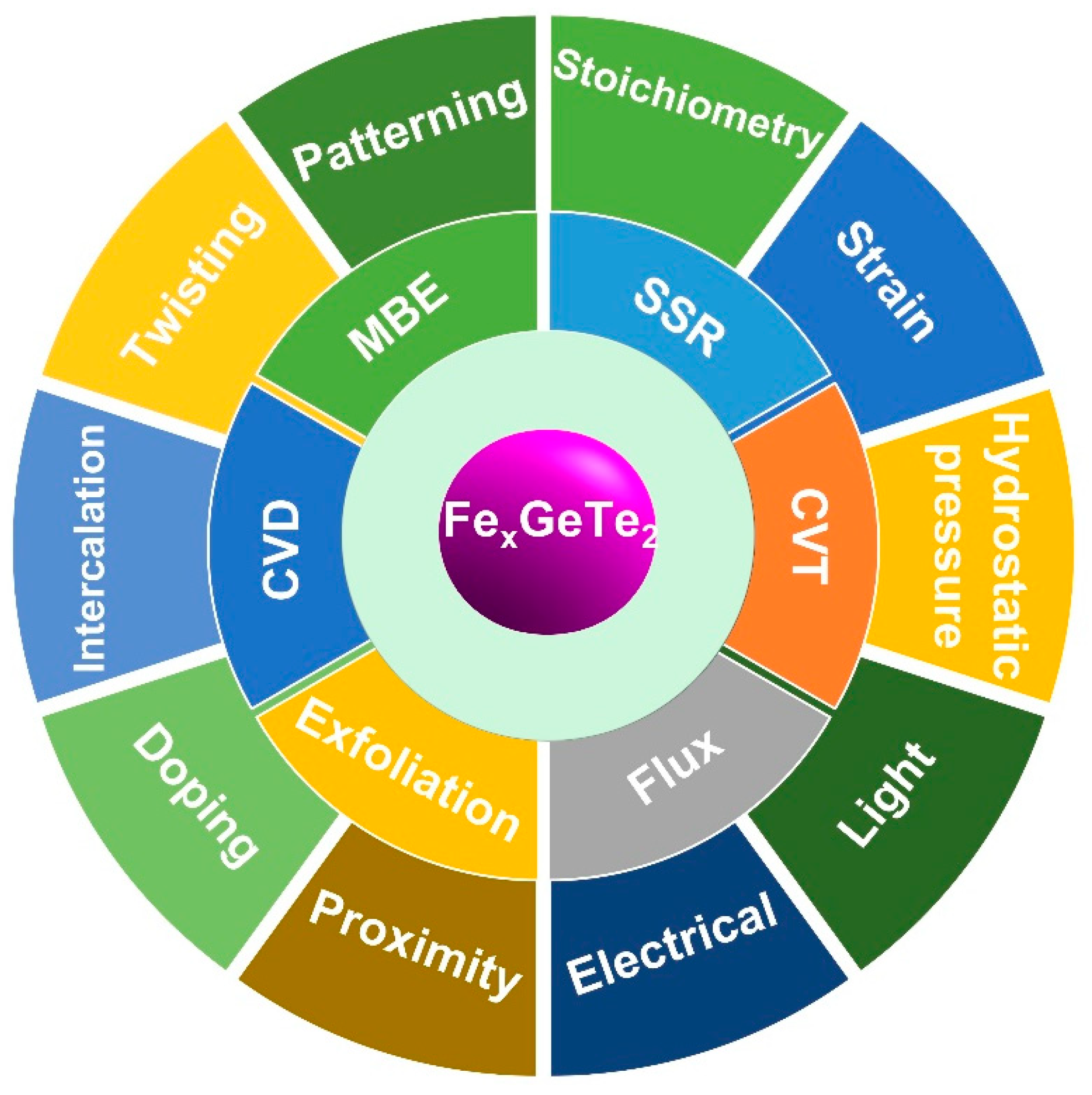


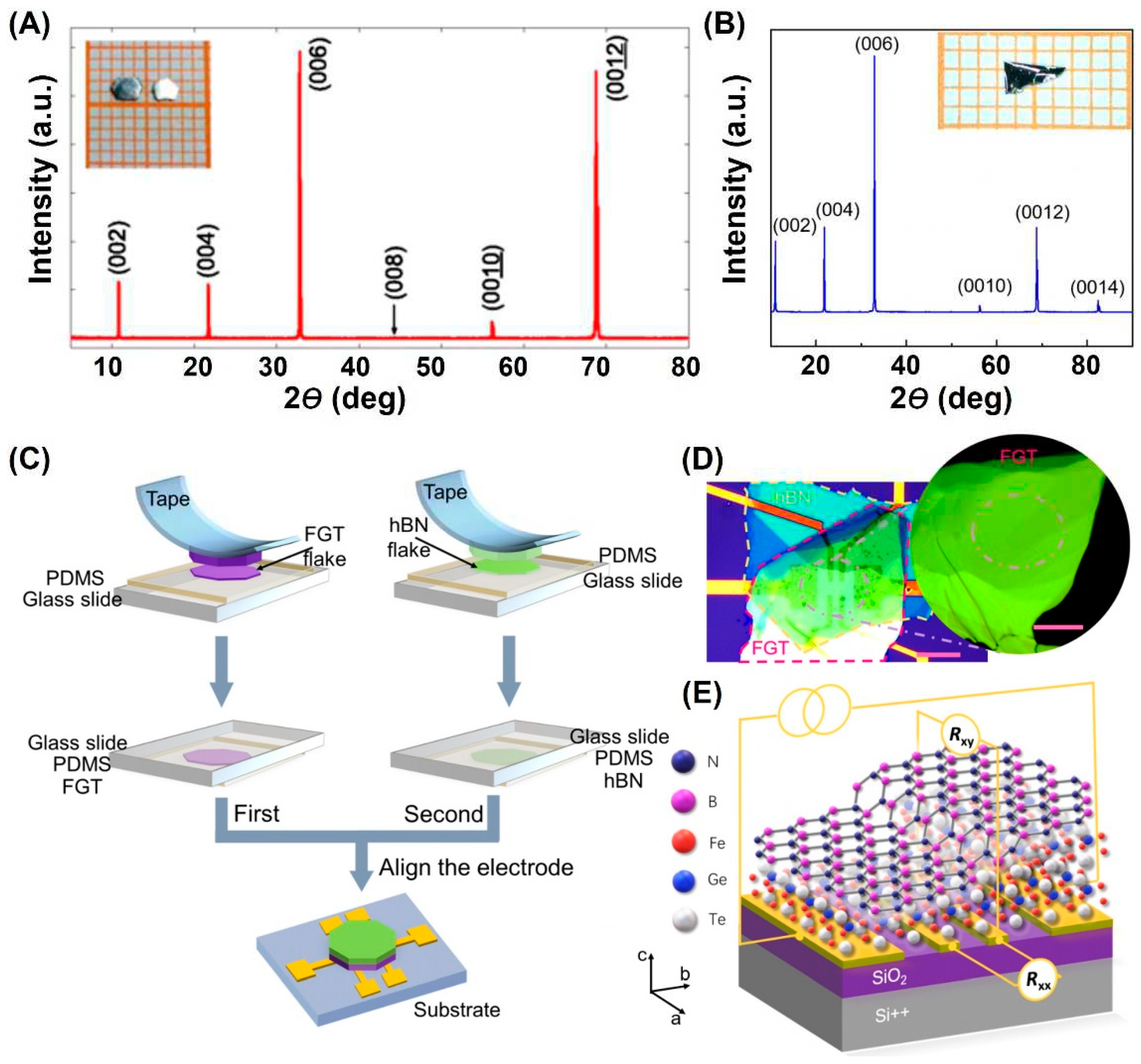
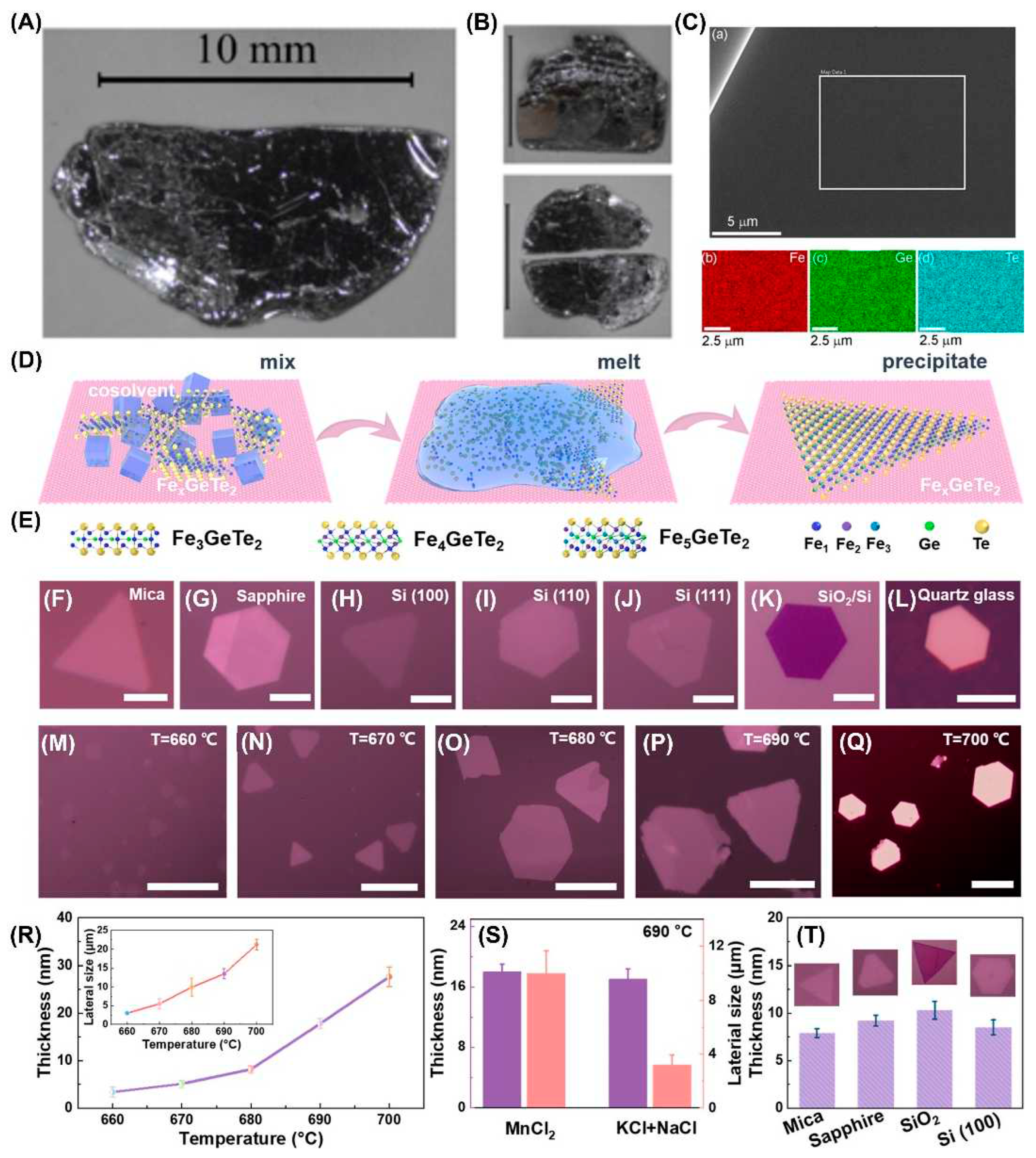
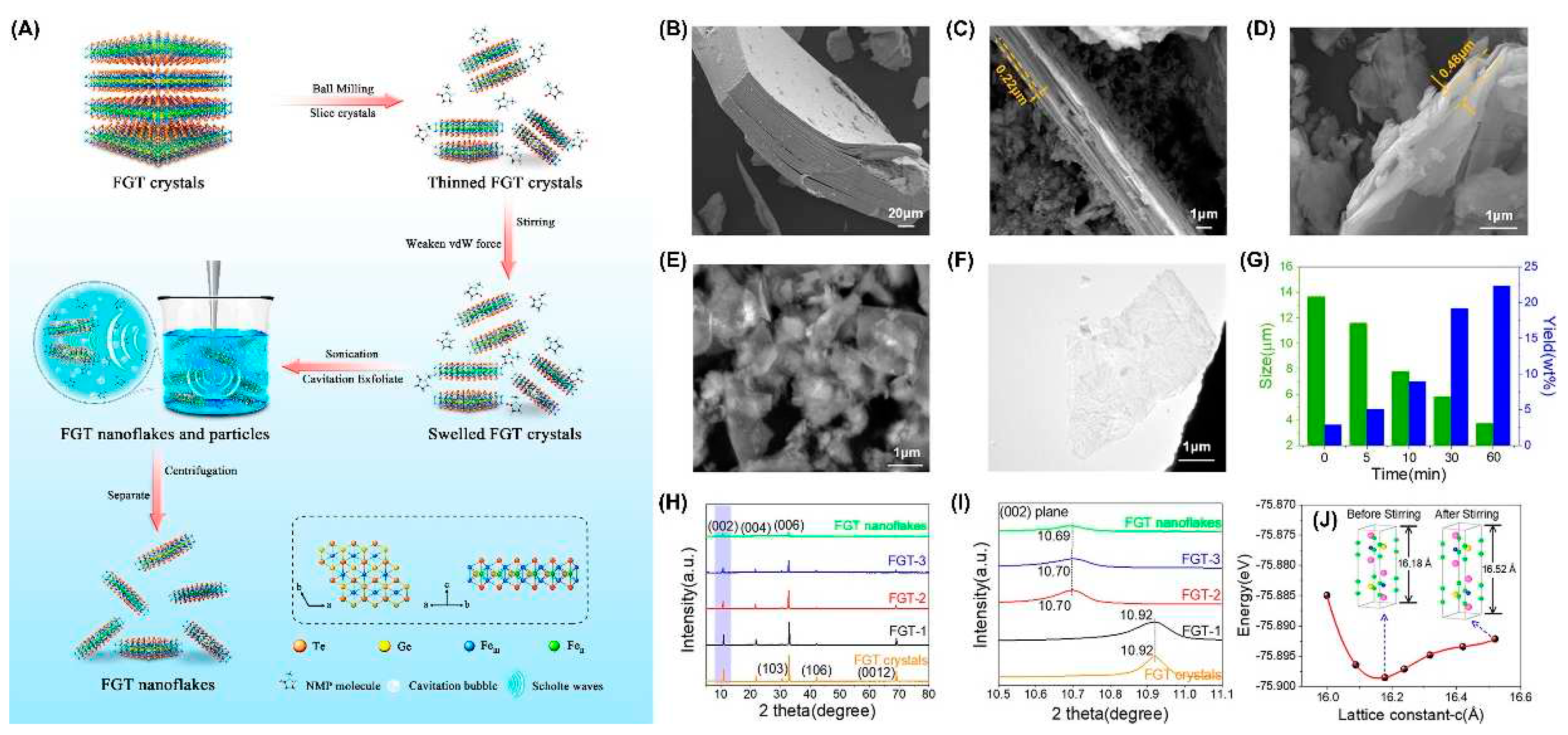
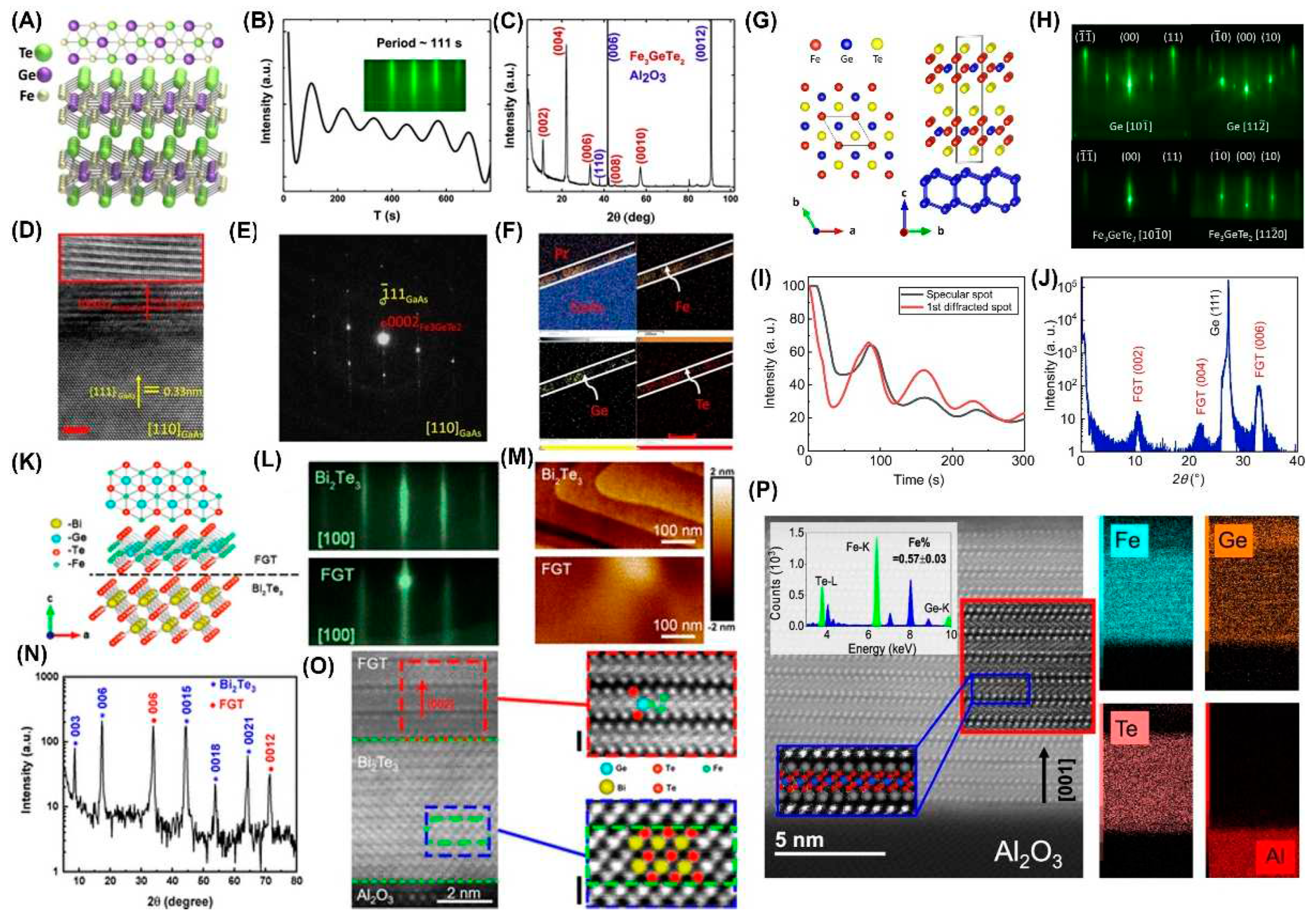
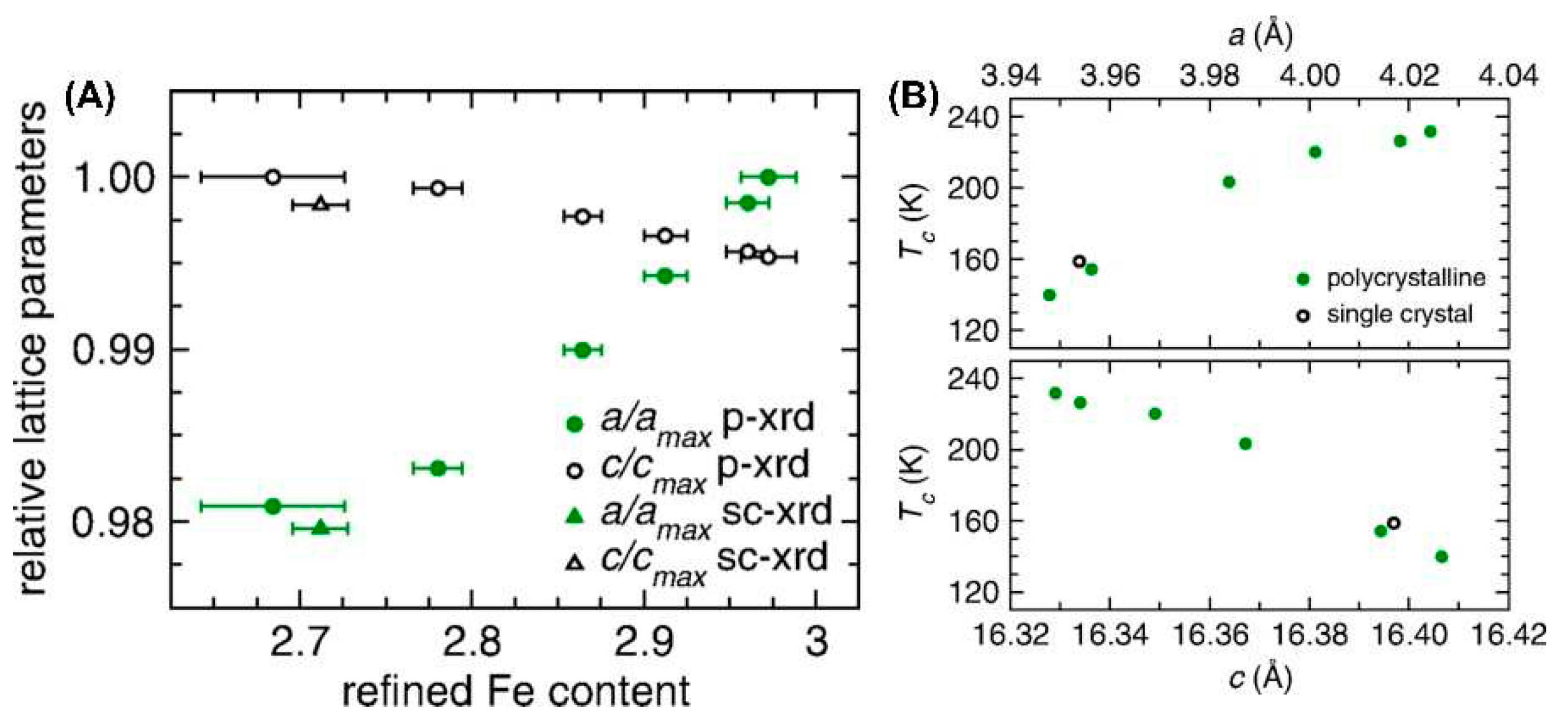
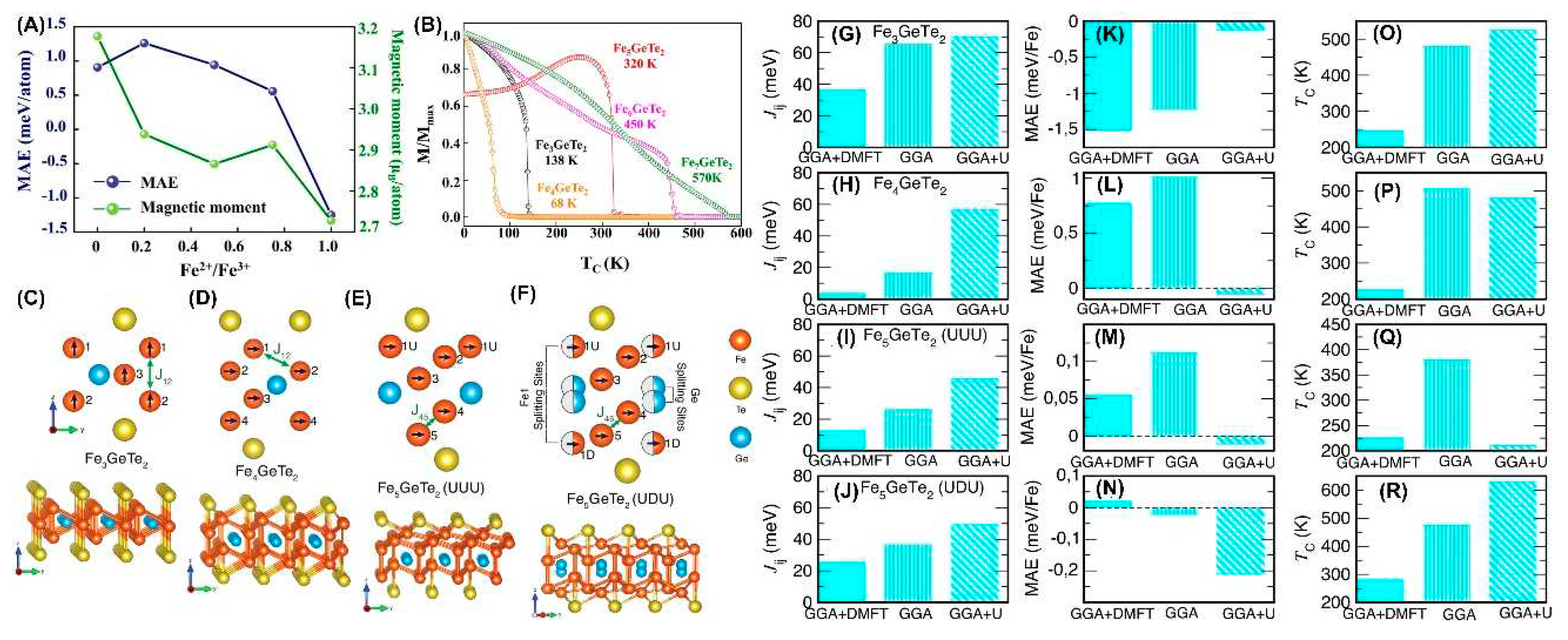
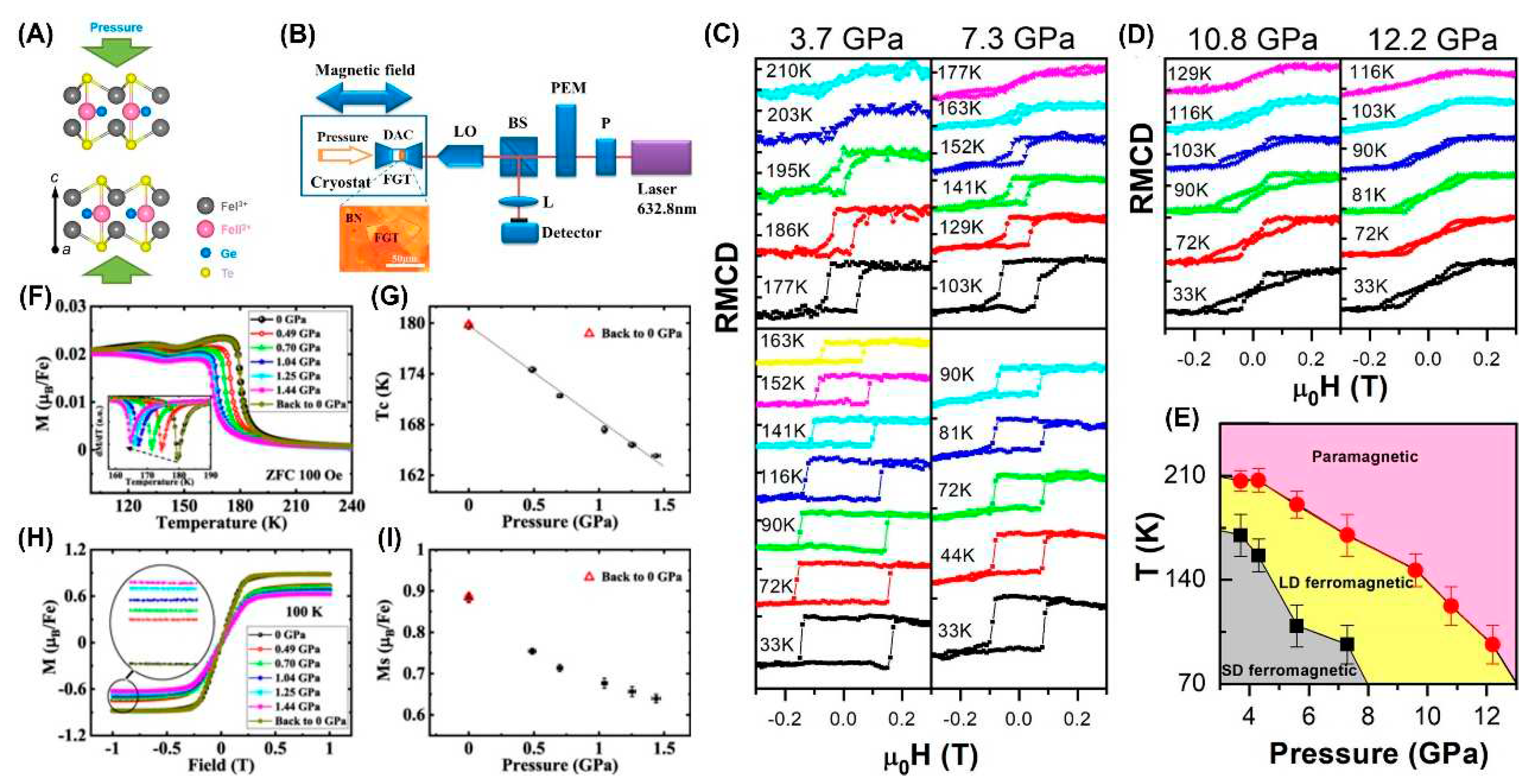

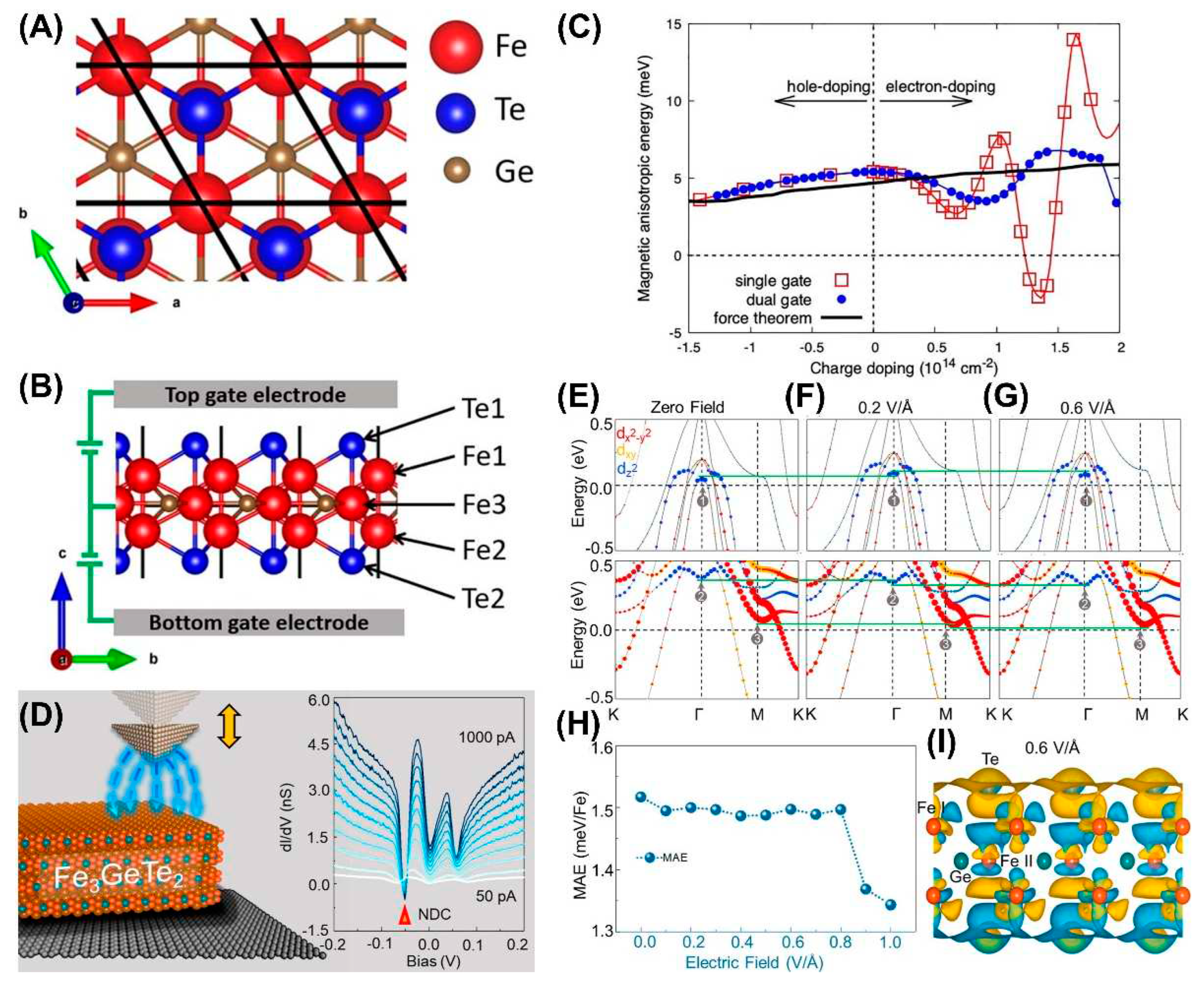
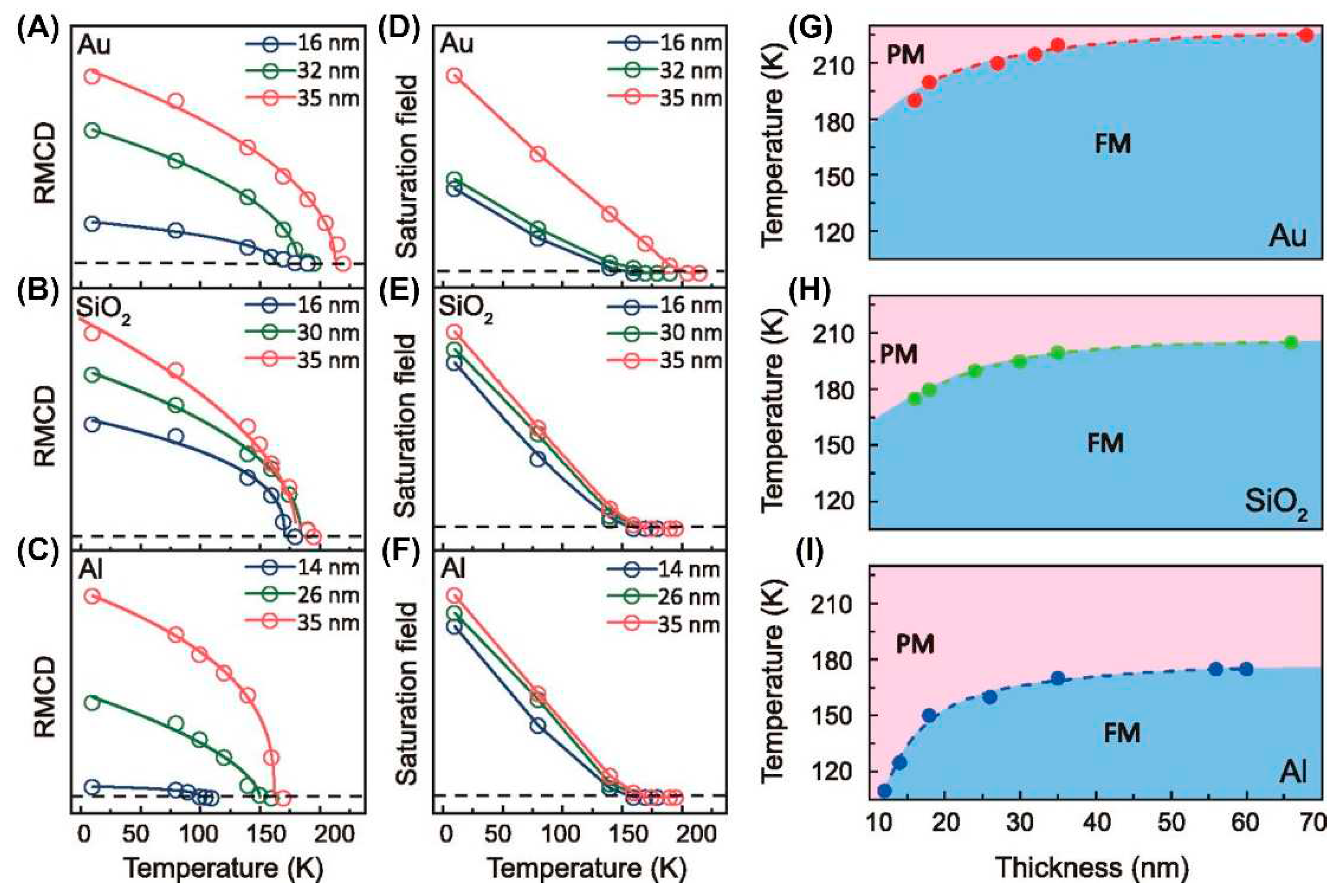

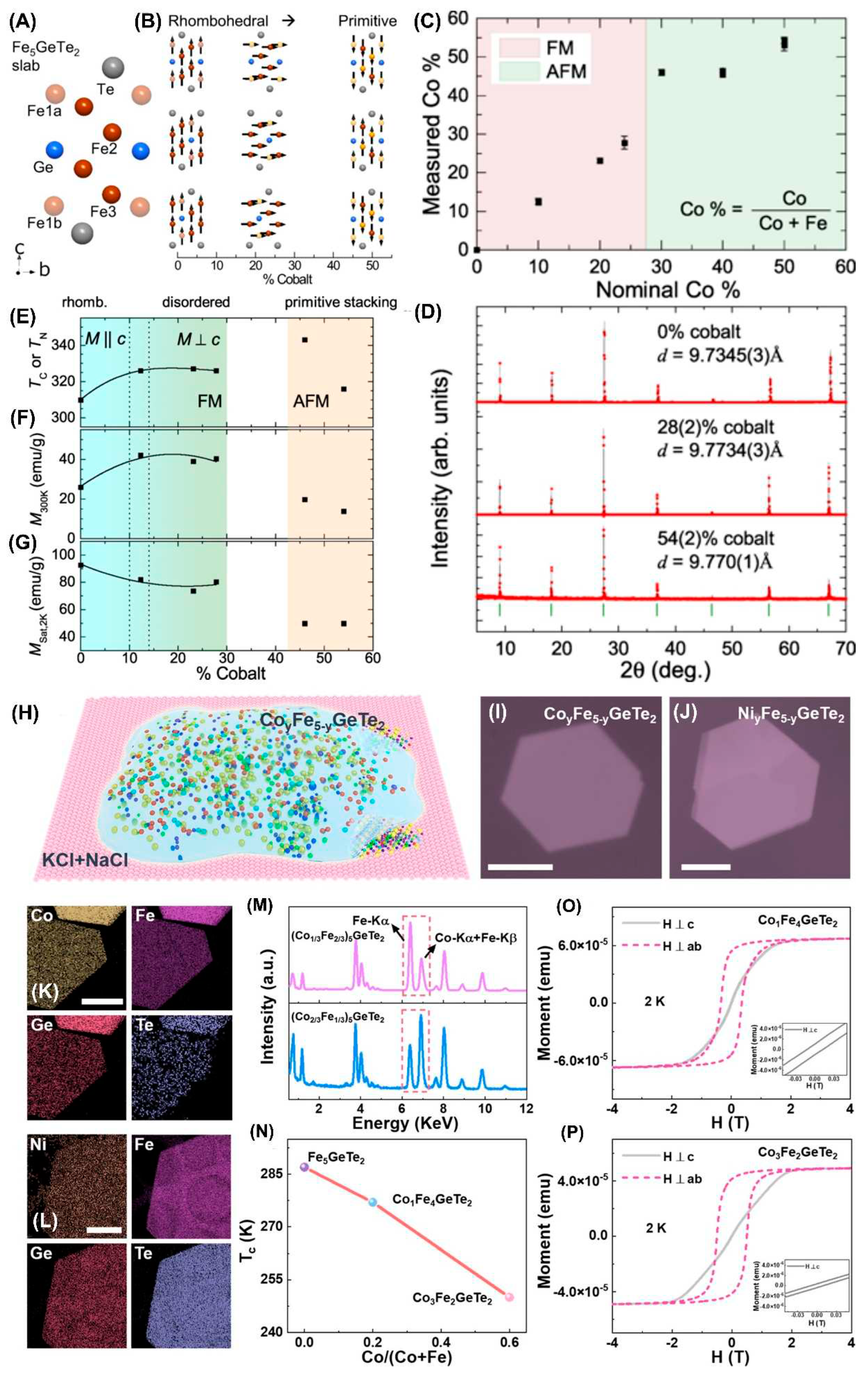
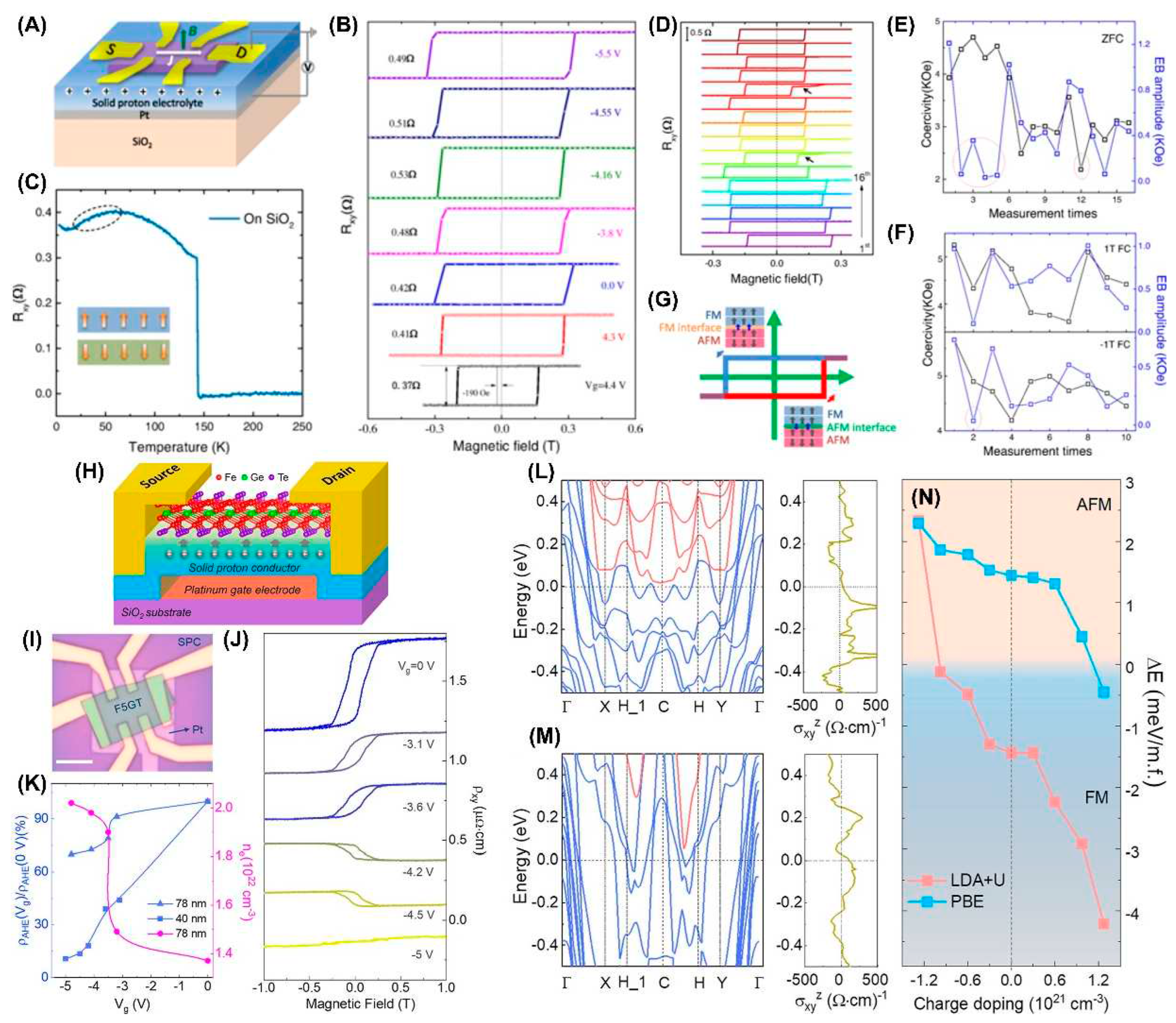
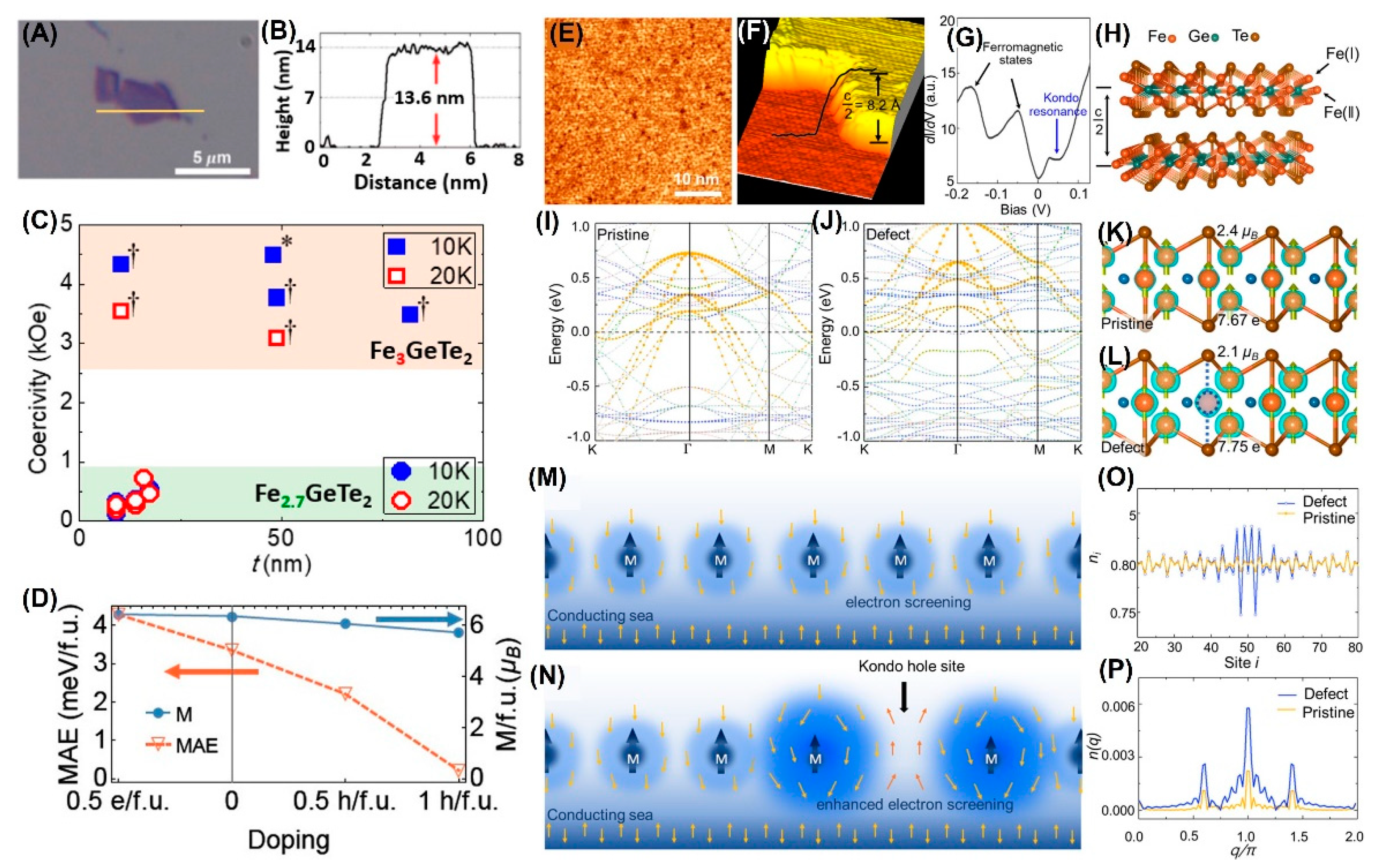
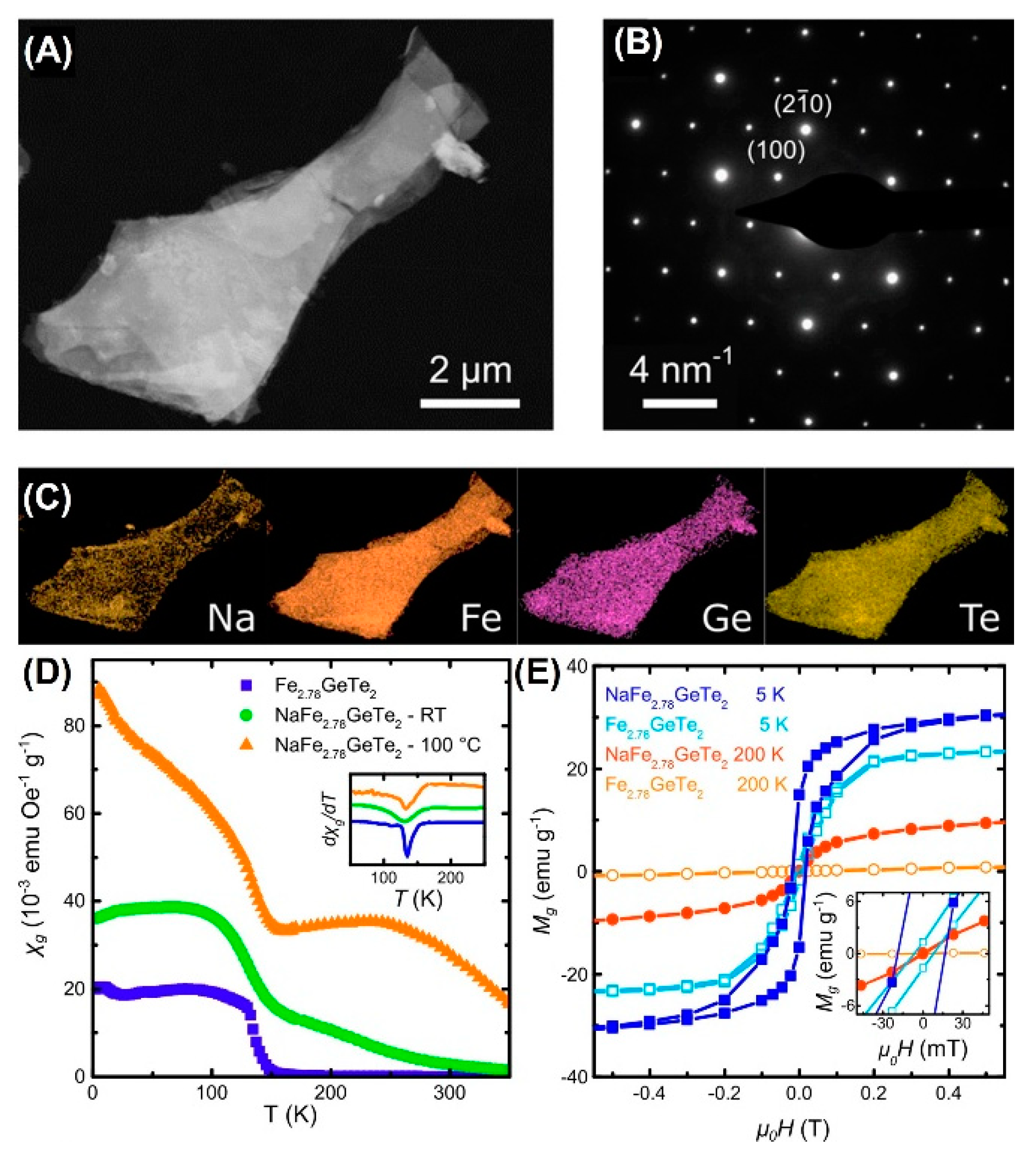
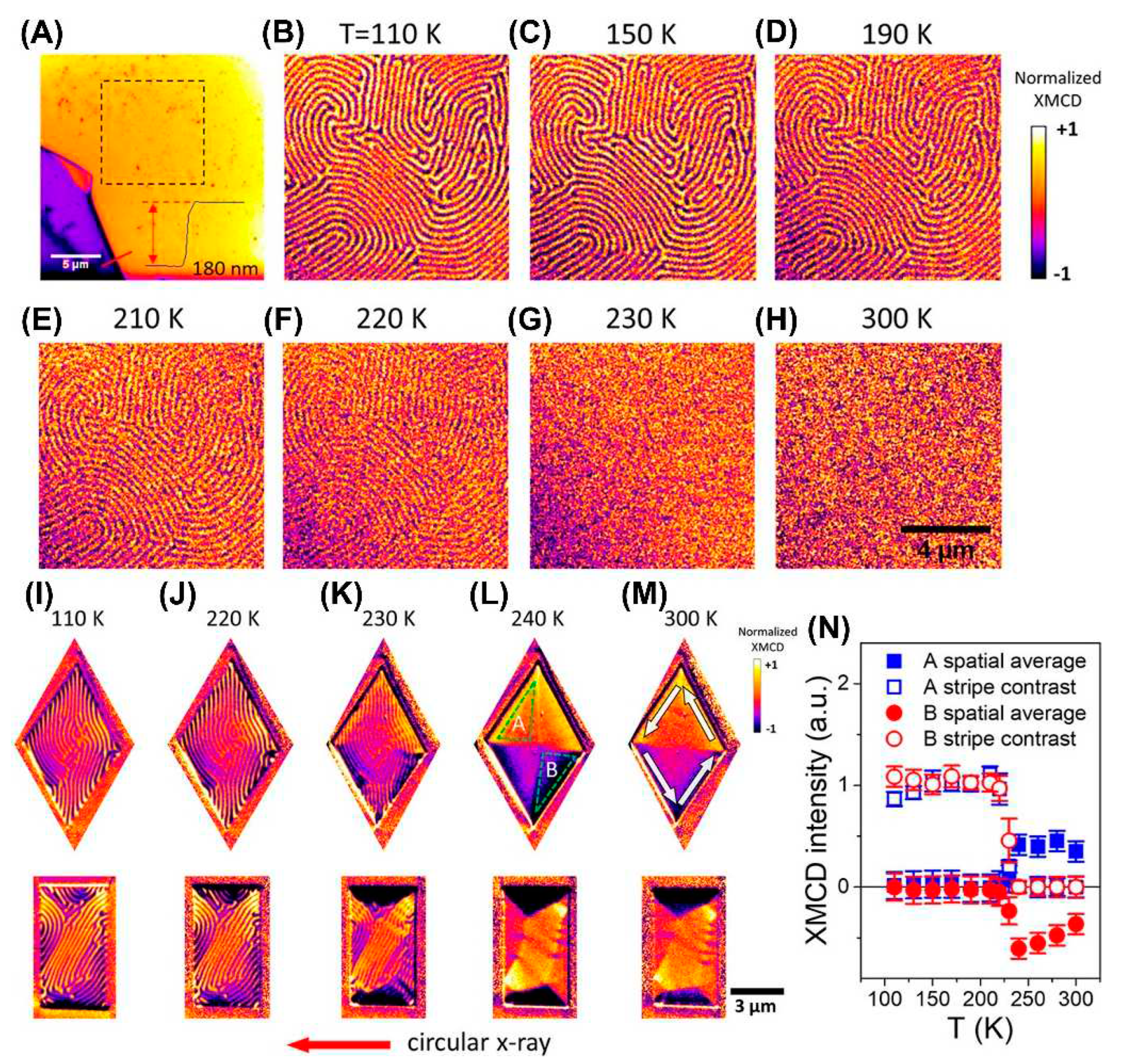

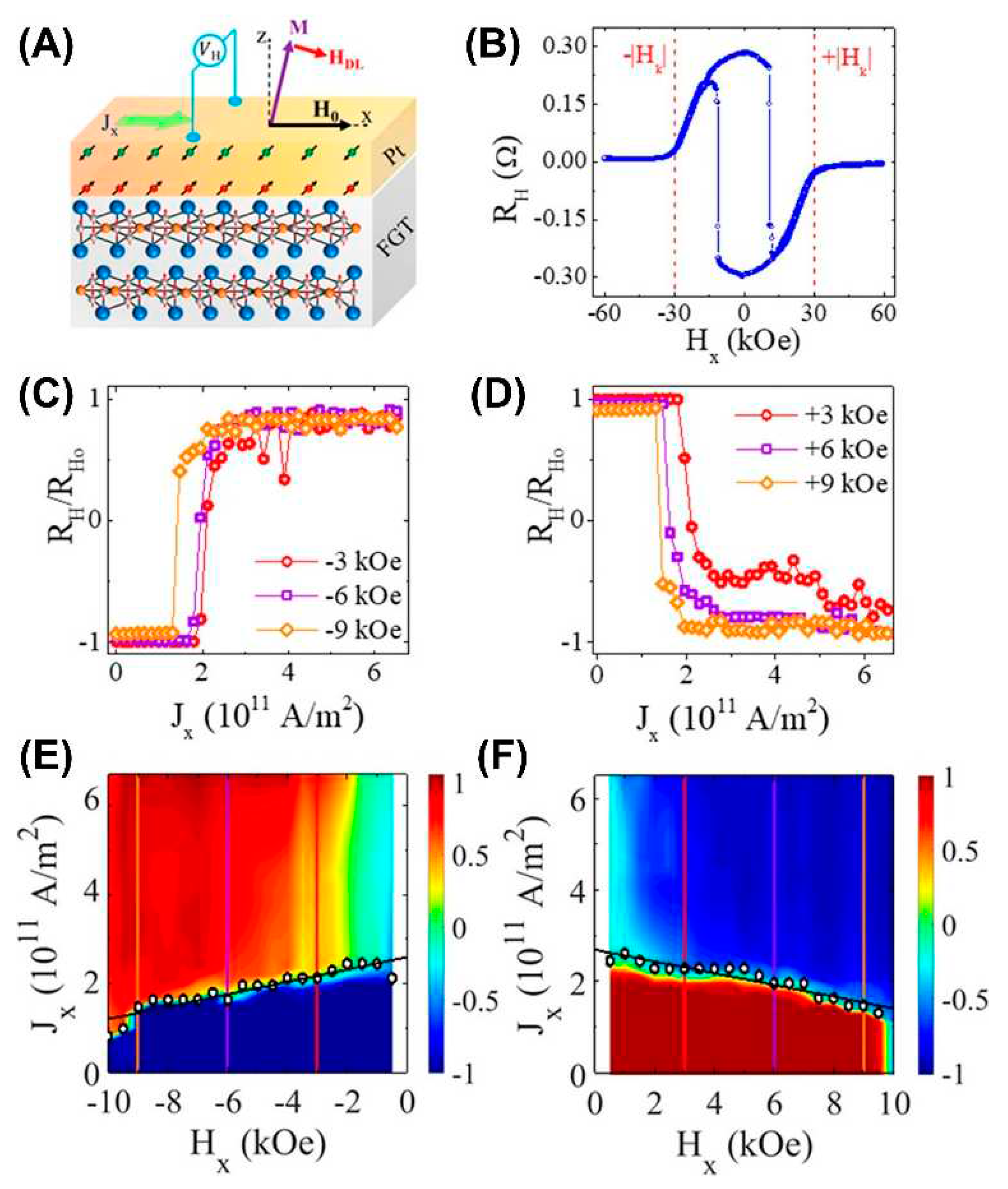
Disclaimer/Publisher’s Note: The statements, opinions and data contained in all publications are solely those of the individual author(s) and contributor(s) and not of MDPI and/or the editor(s). MDPI and/or the editor(s) disclaim responsibility for any injury to people or property resulting from any ideas, methods, instructions or products referred to in the content. |
© 2023 by the authors. Licensee MDPI, Basel, Switzerland. This article is an open access article distributed under the terms and conditions of the Creative Commons Attribution (CC BY) license (http://creativecommons.org/licenses/by/4.0/).




